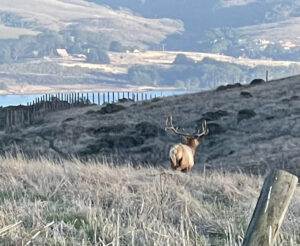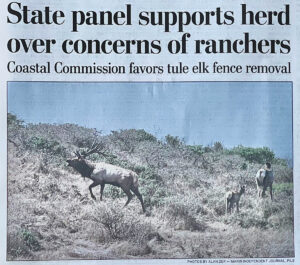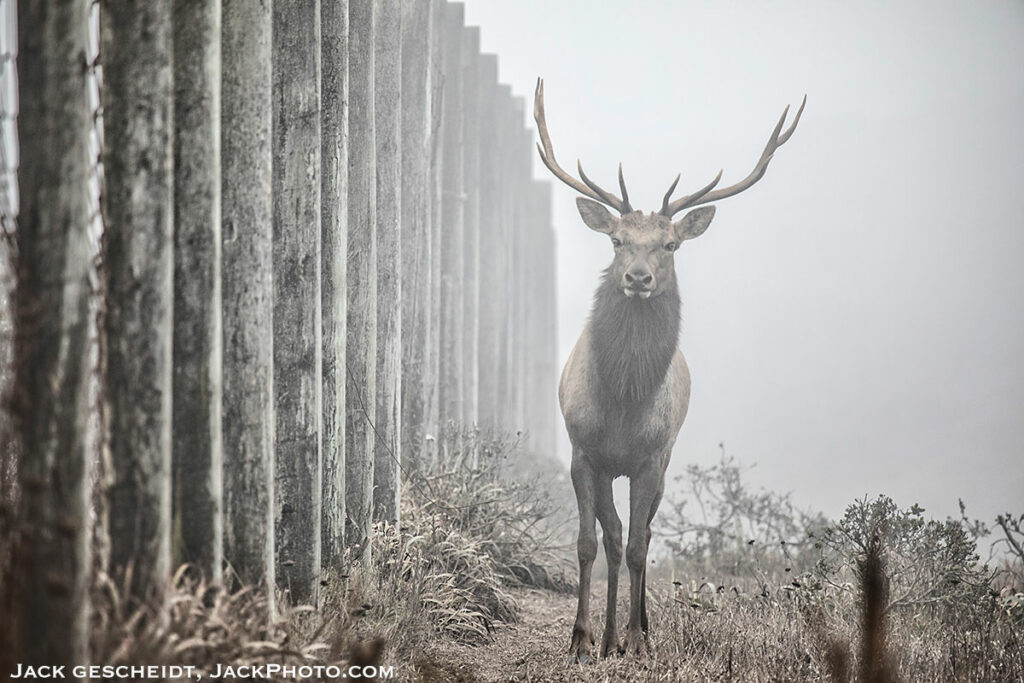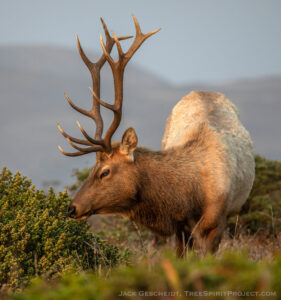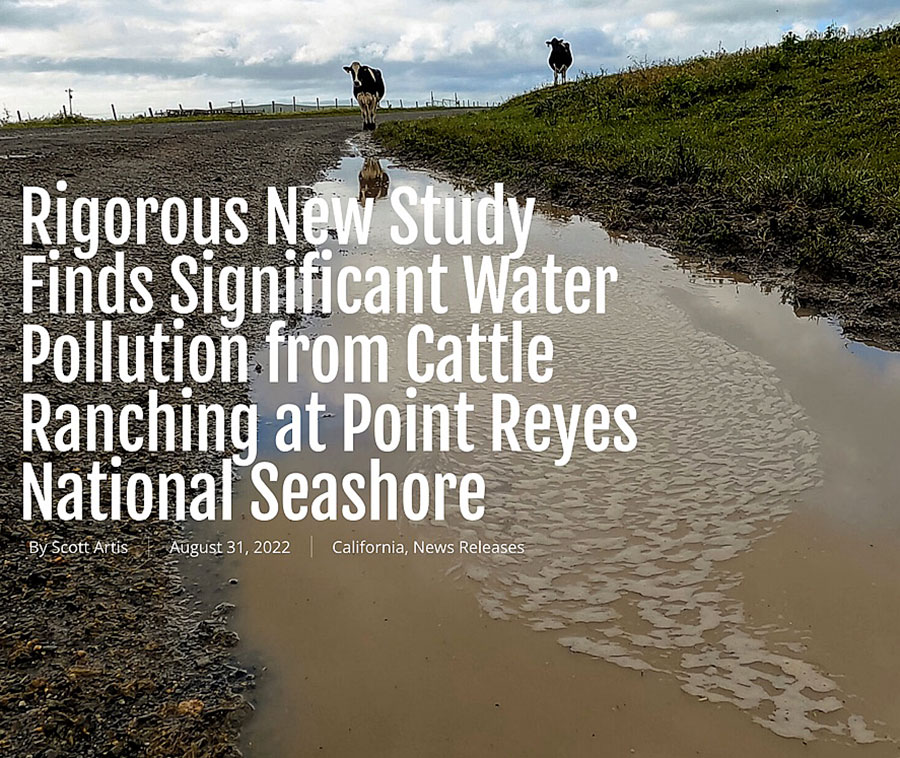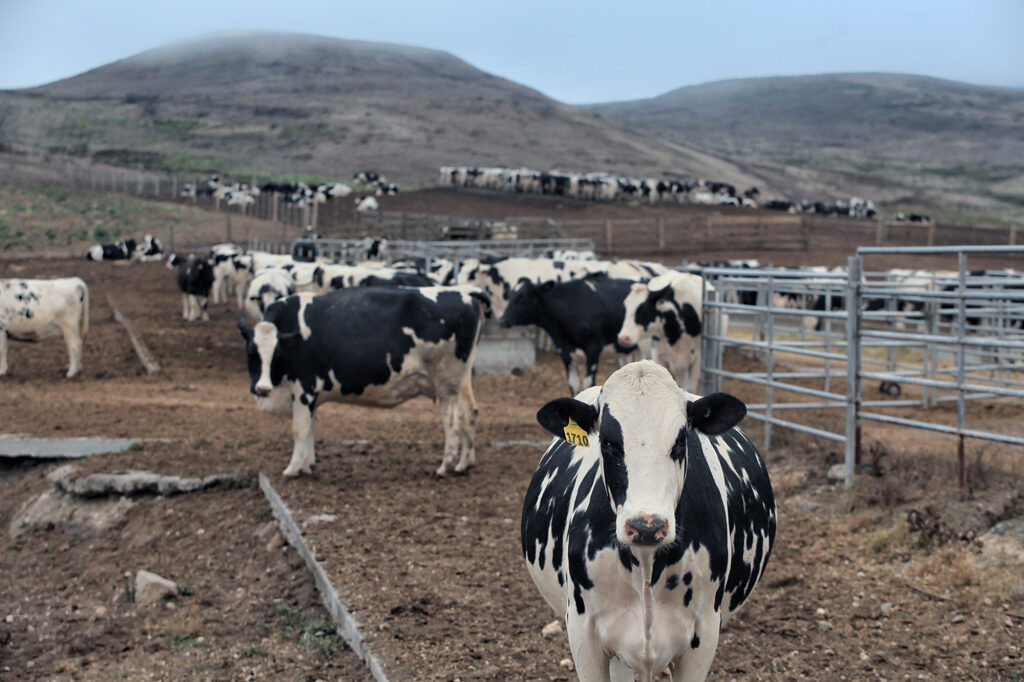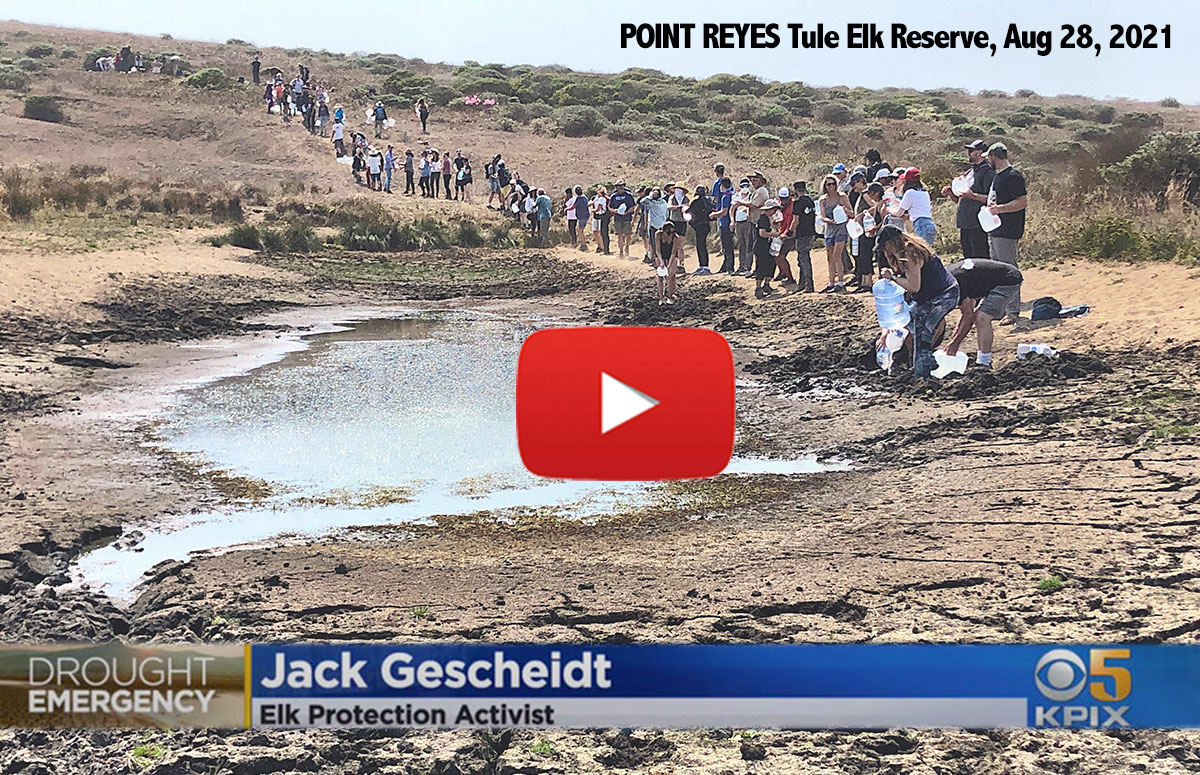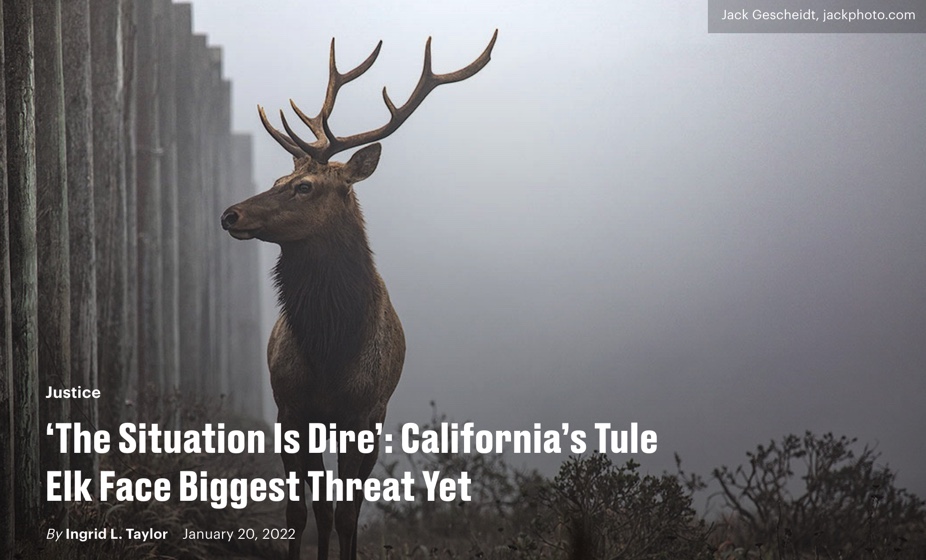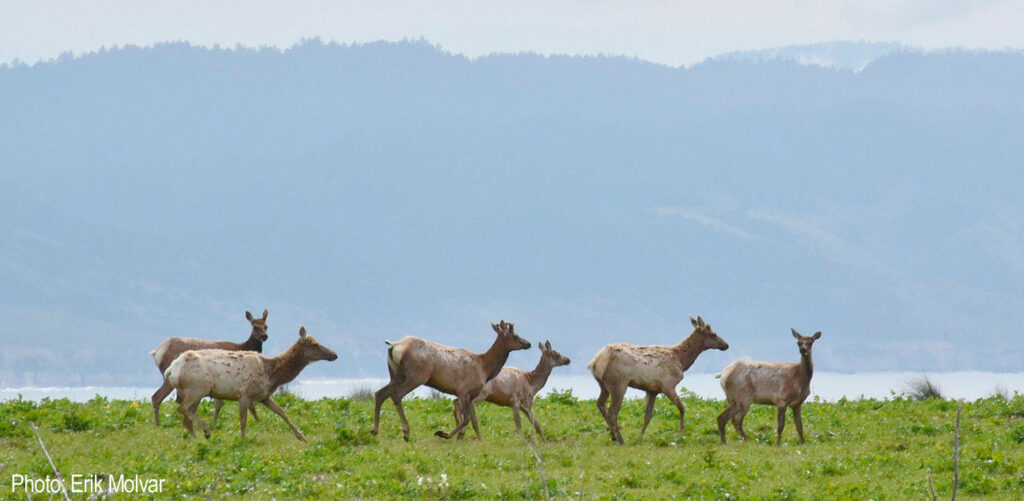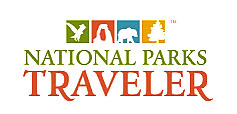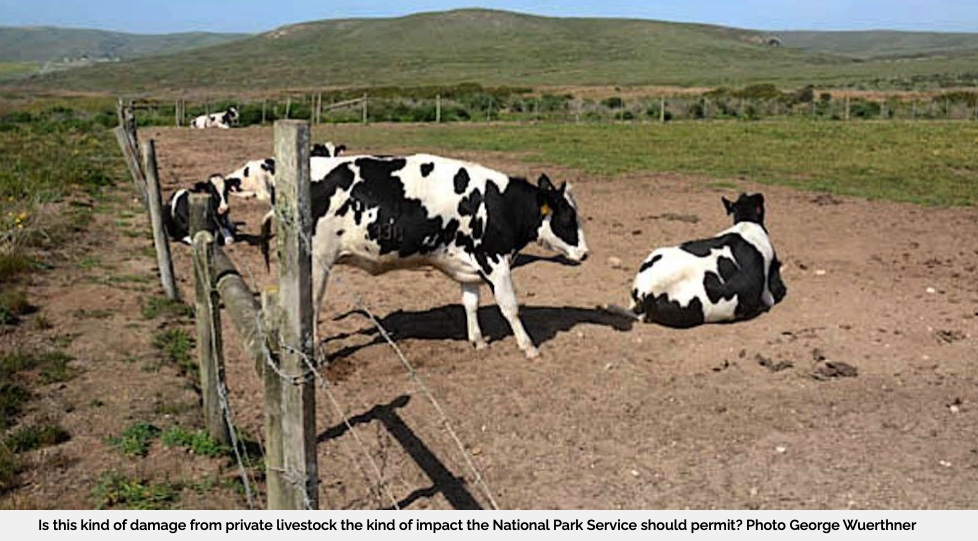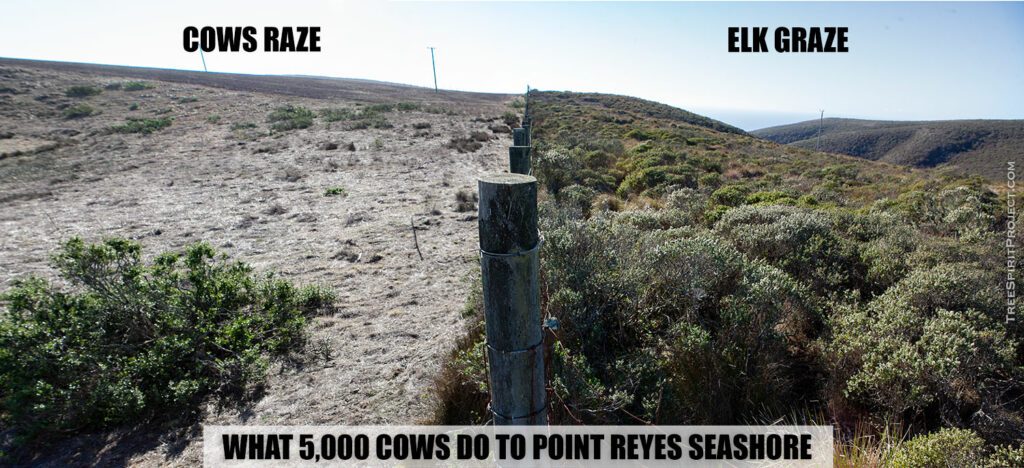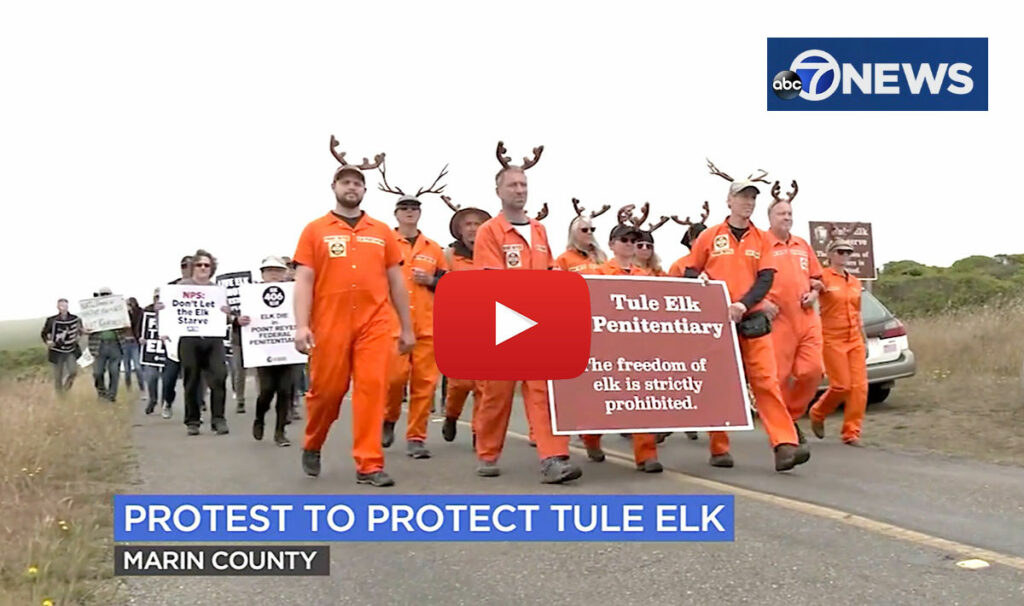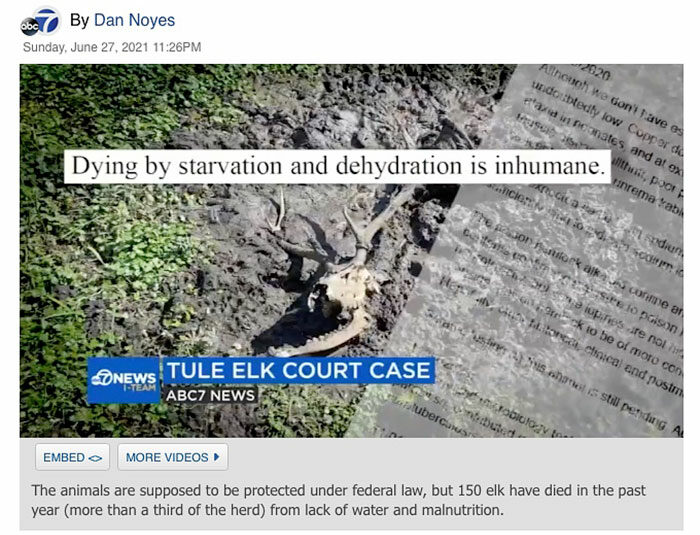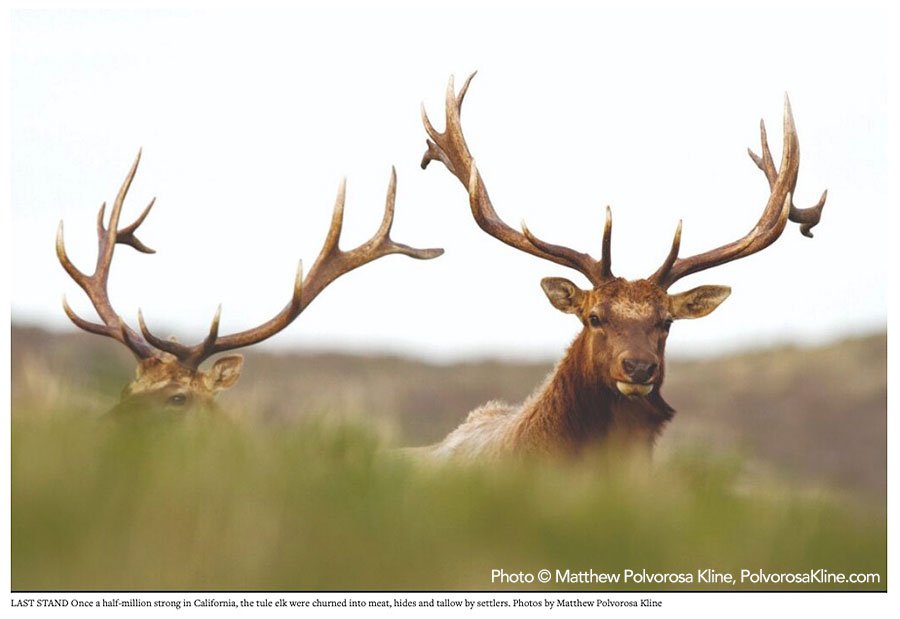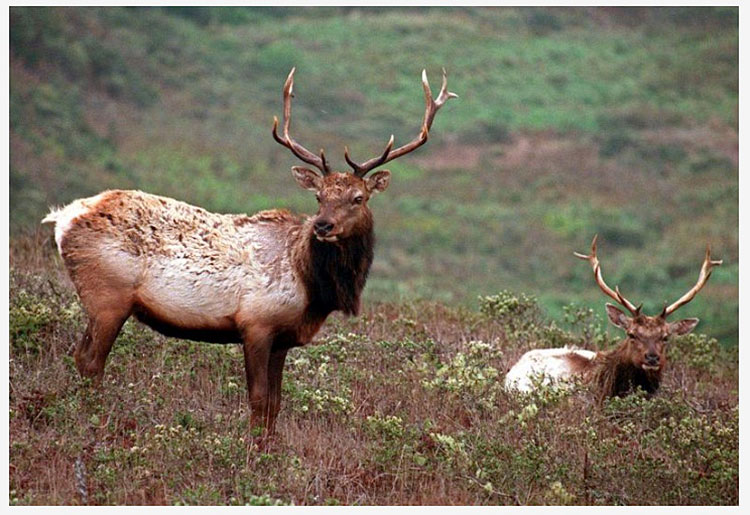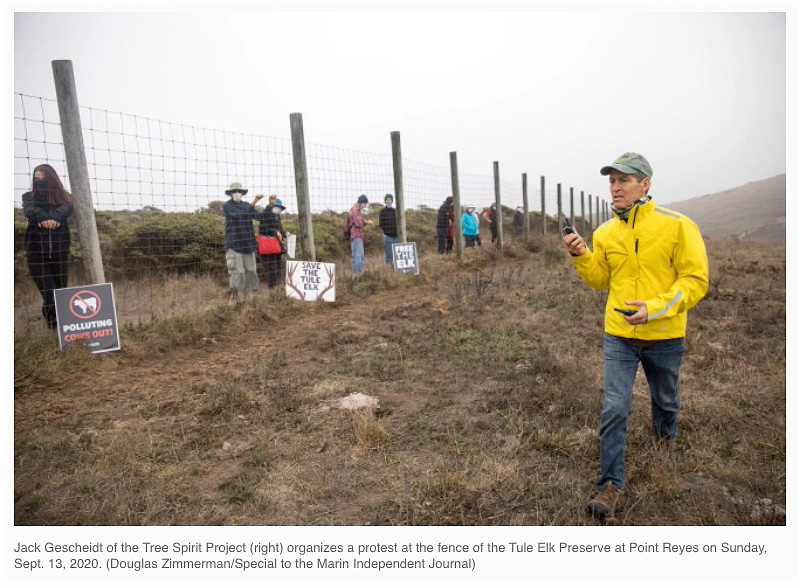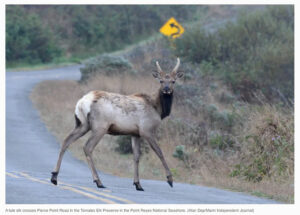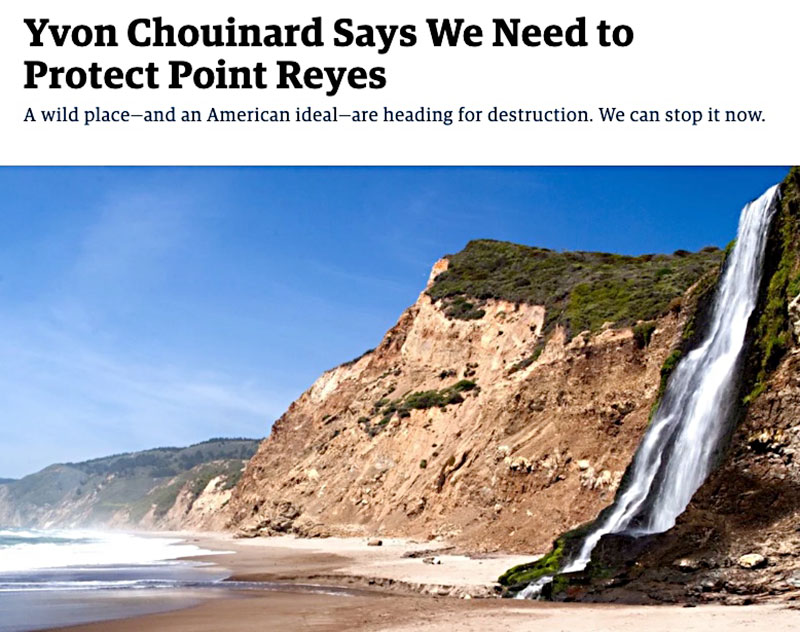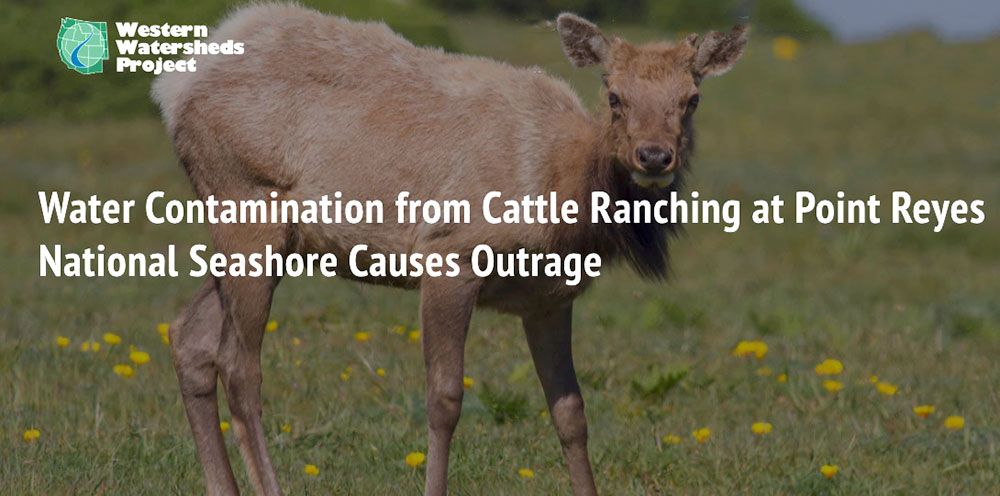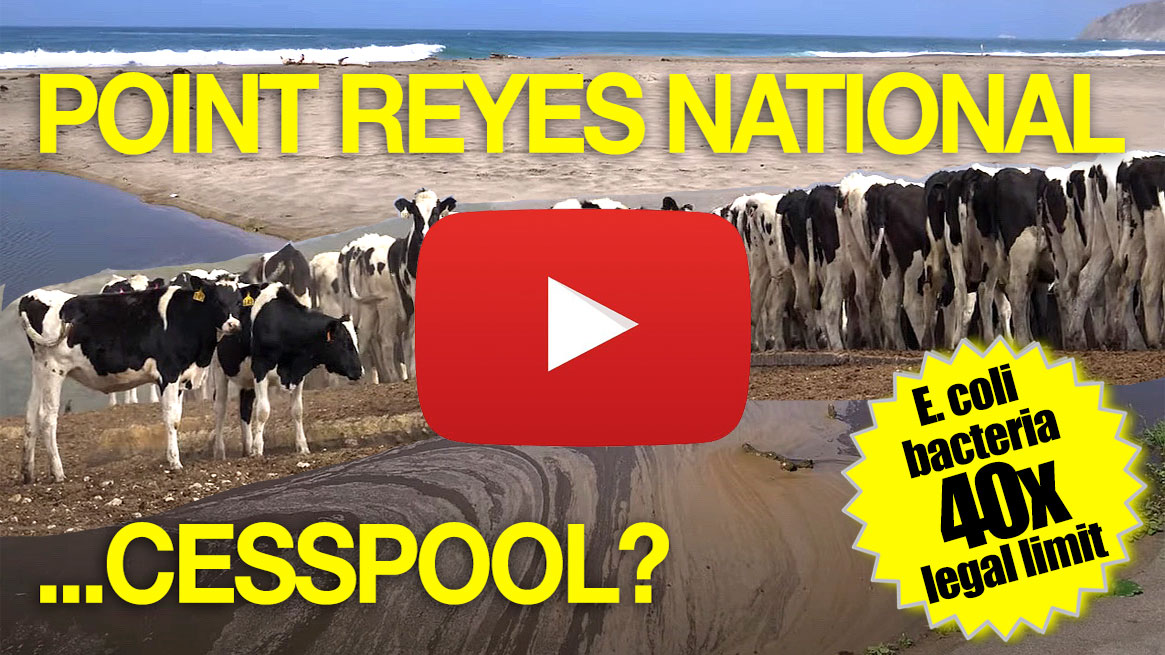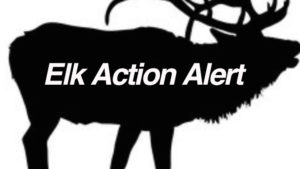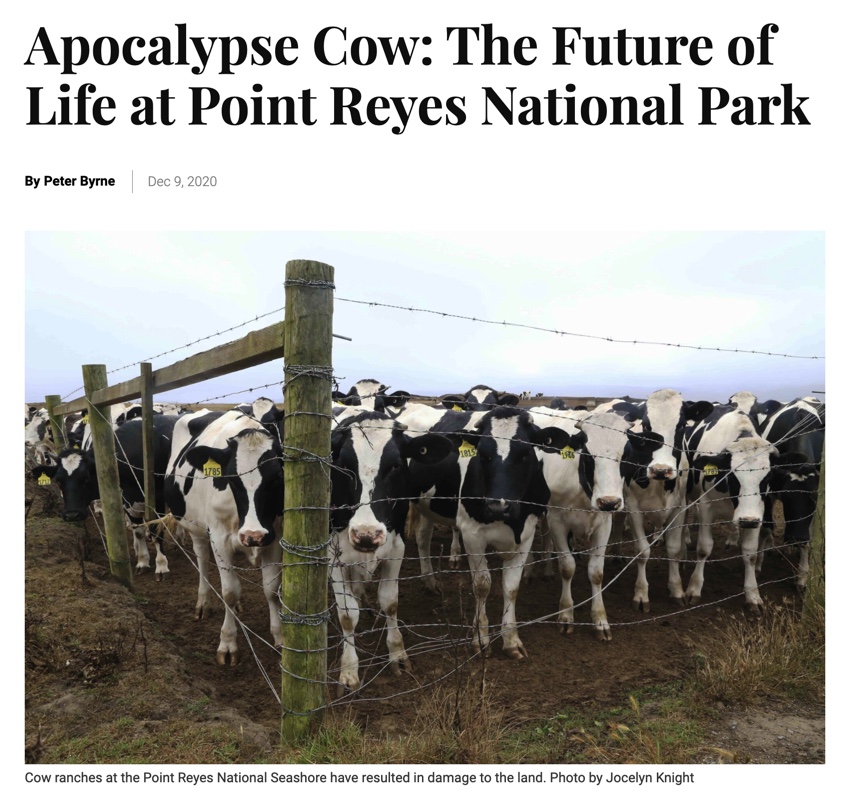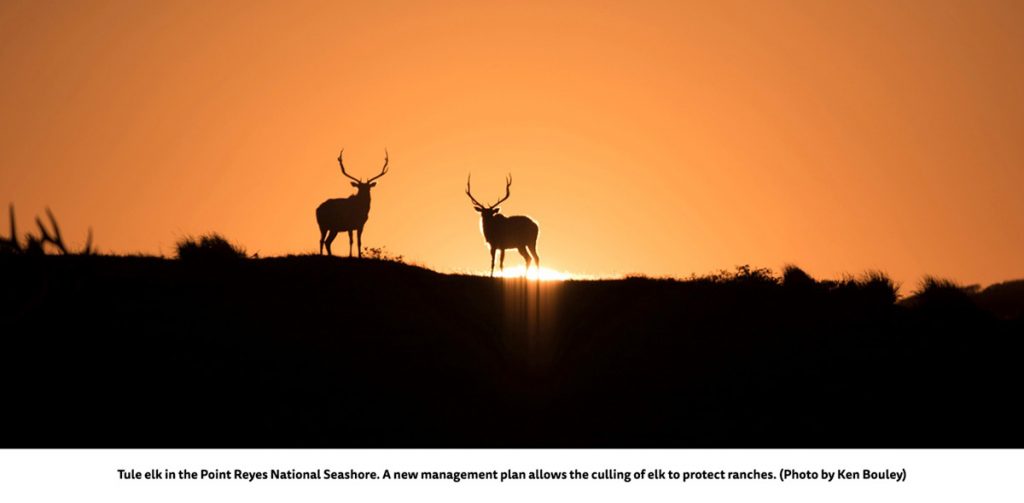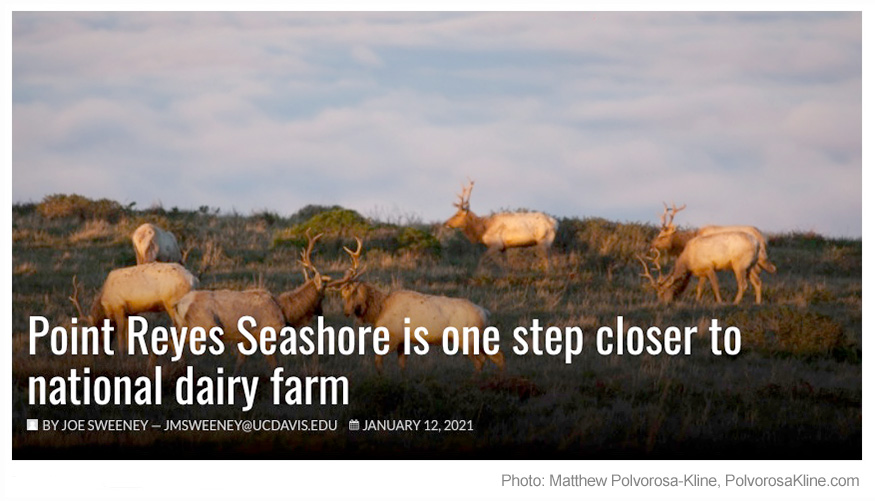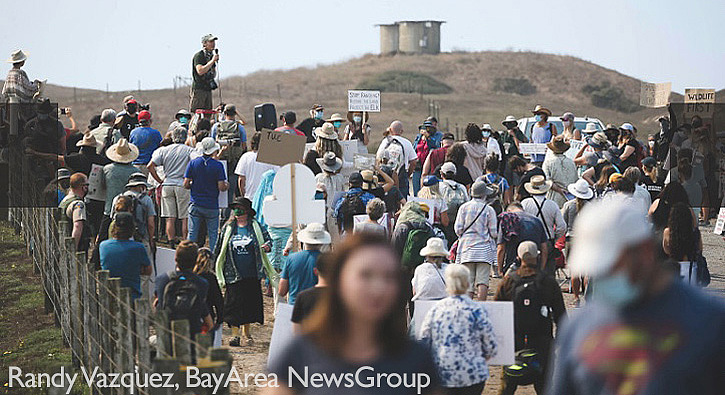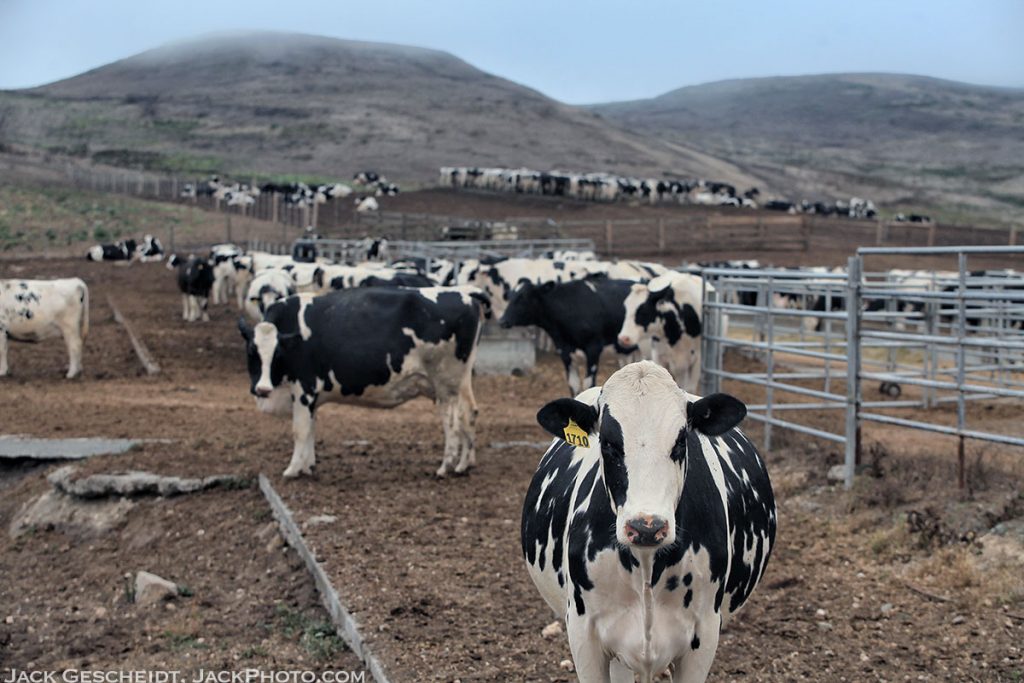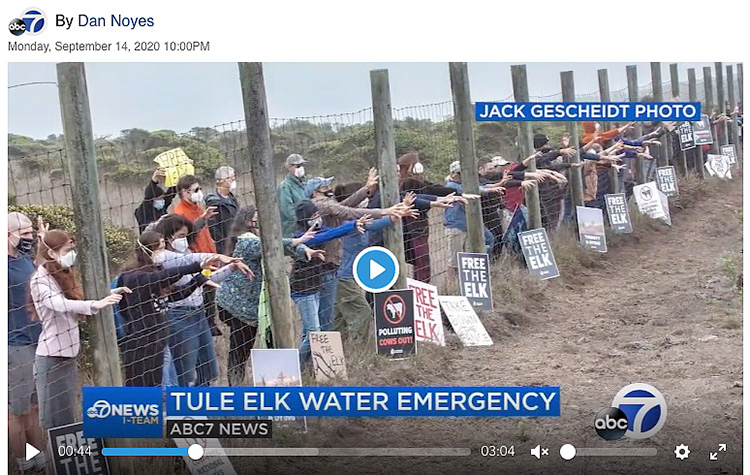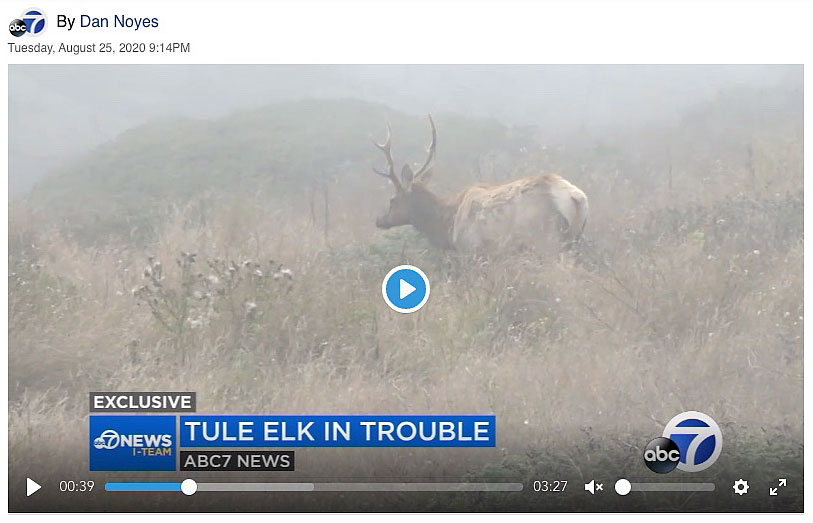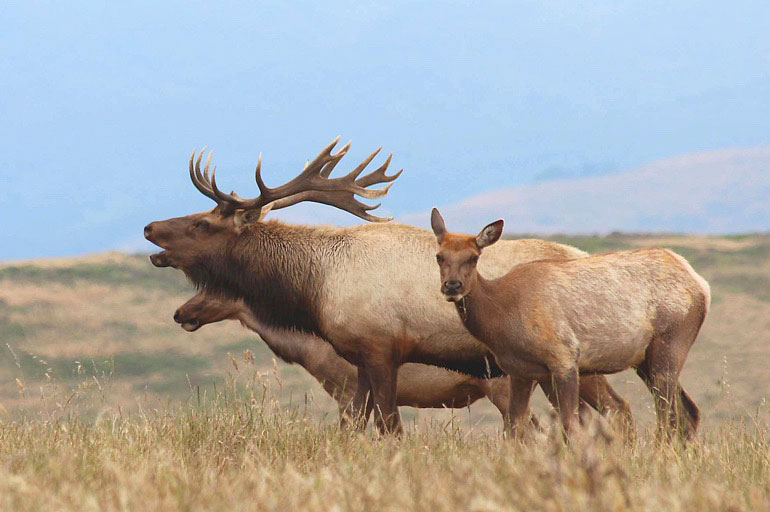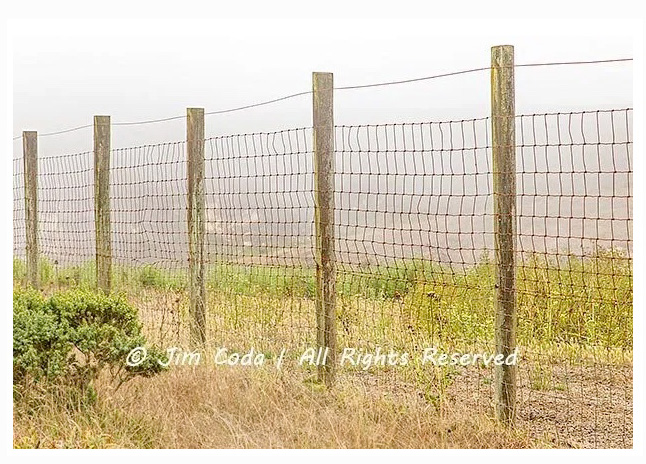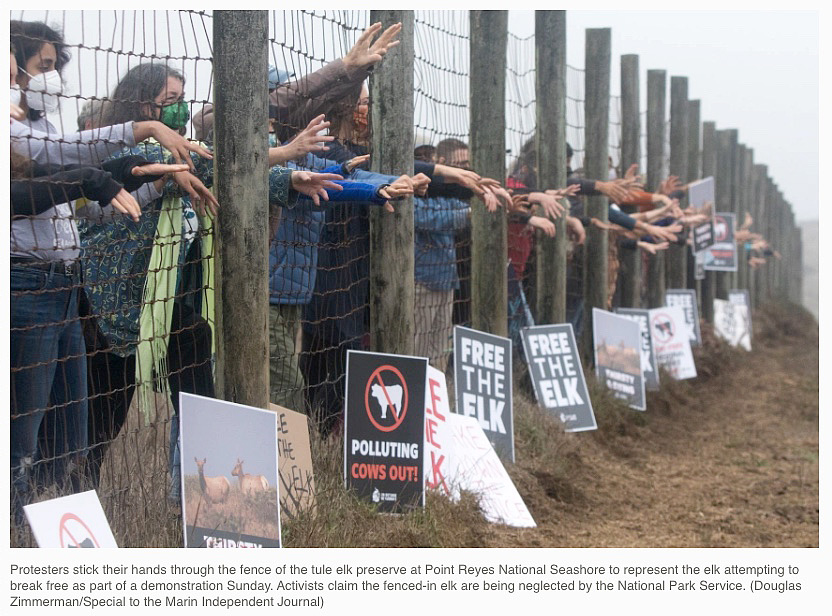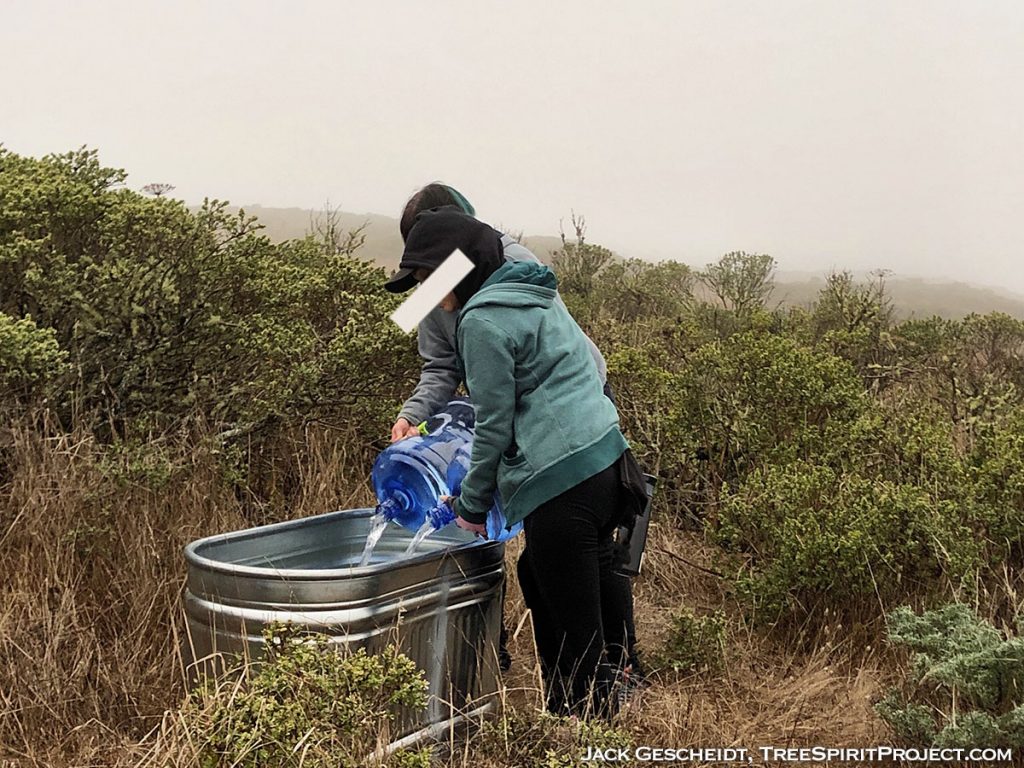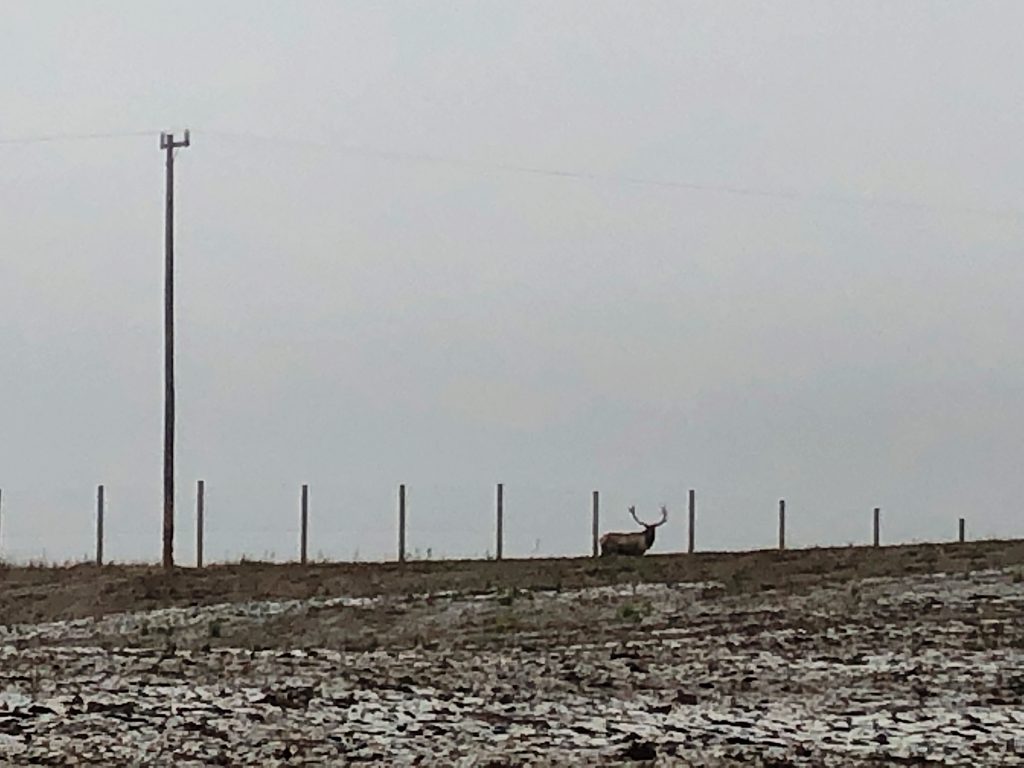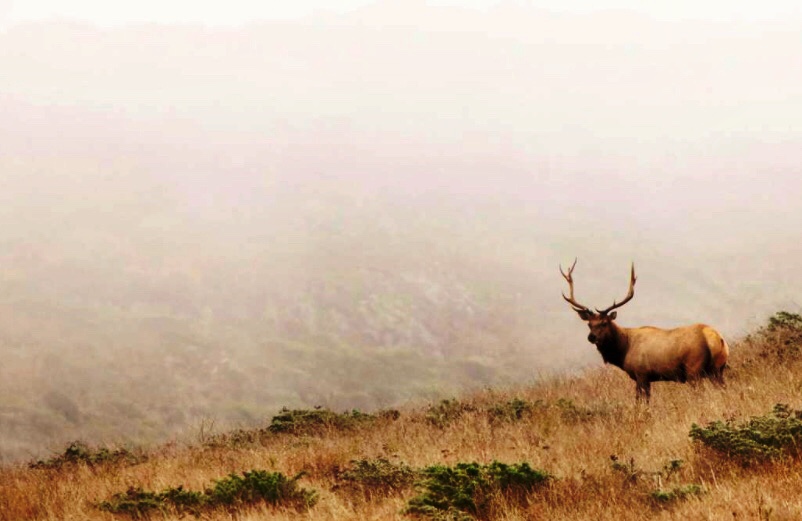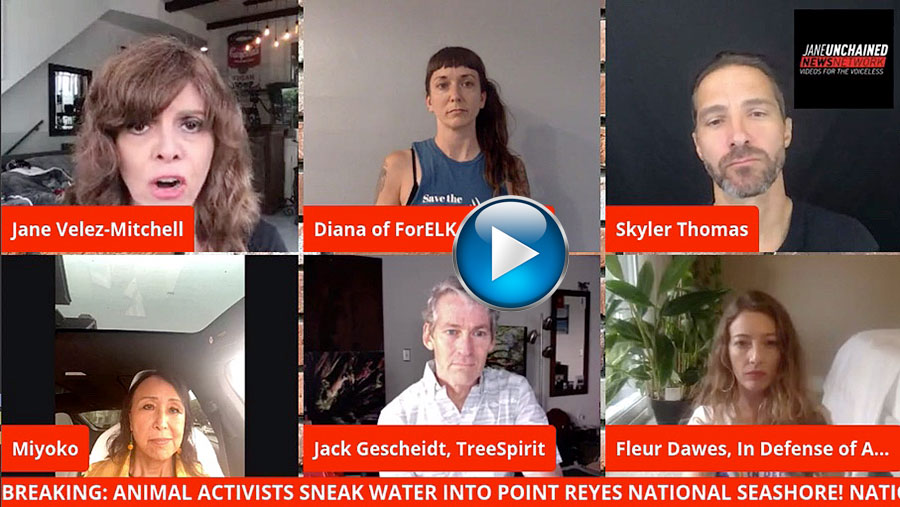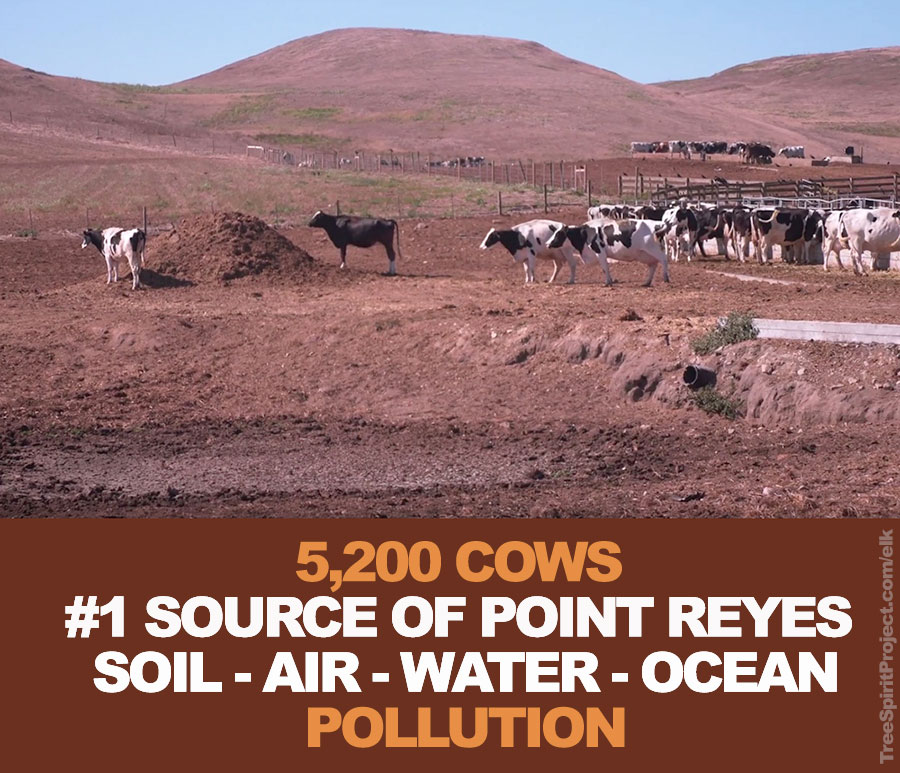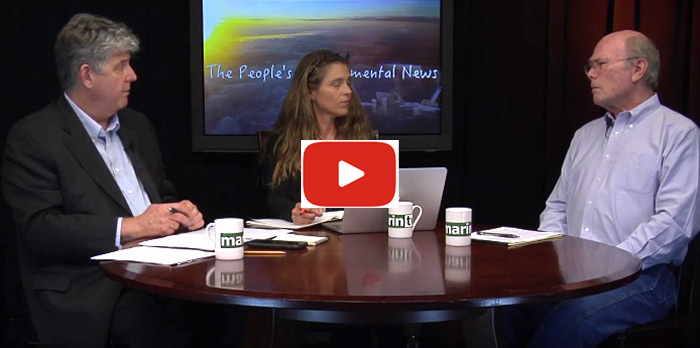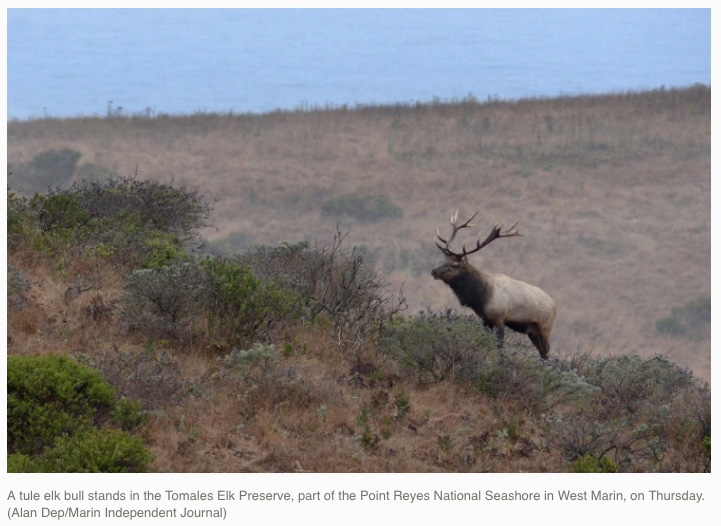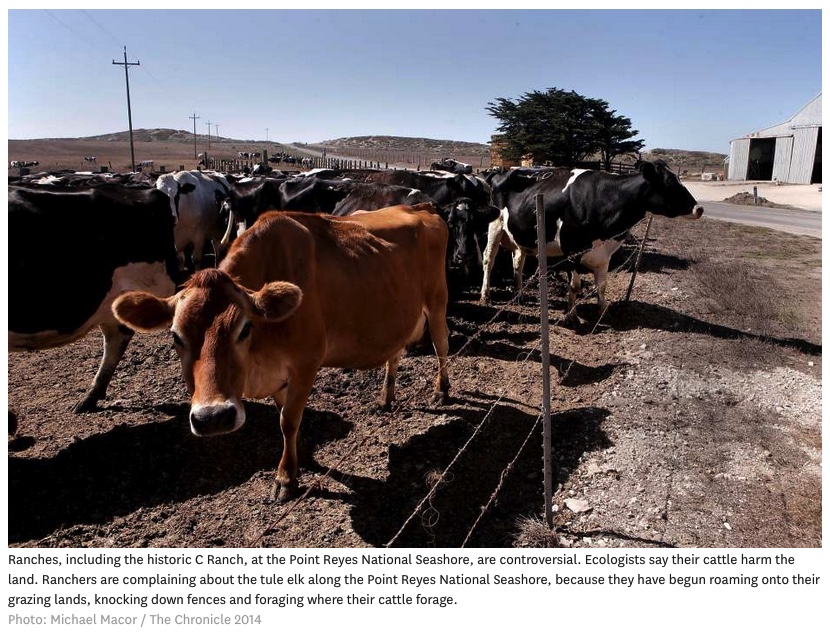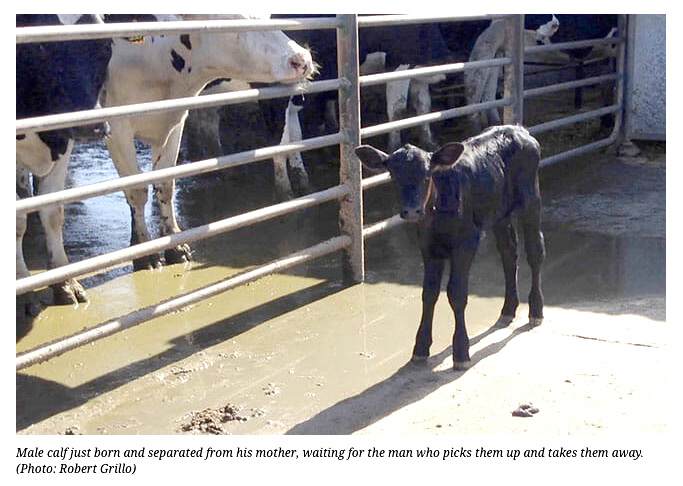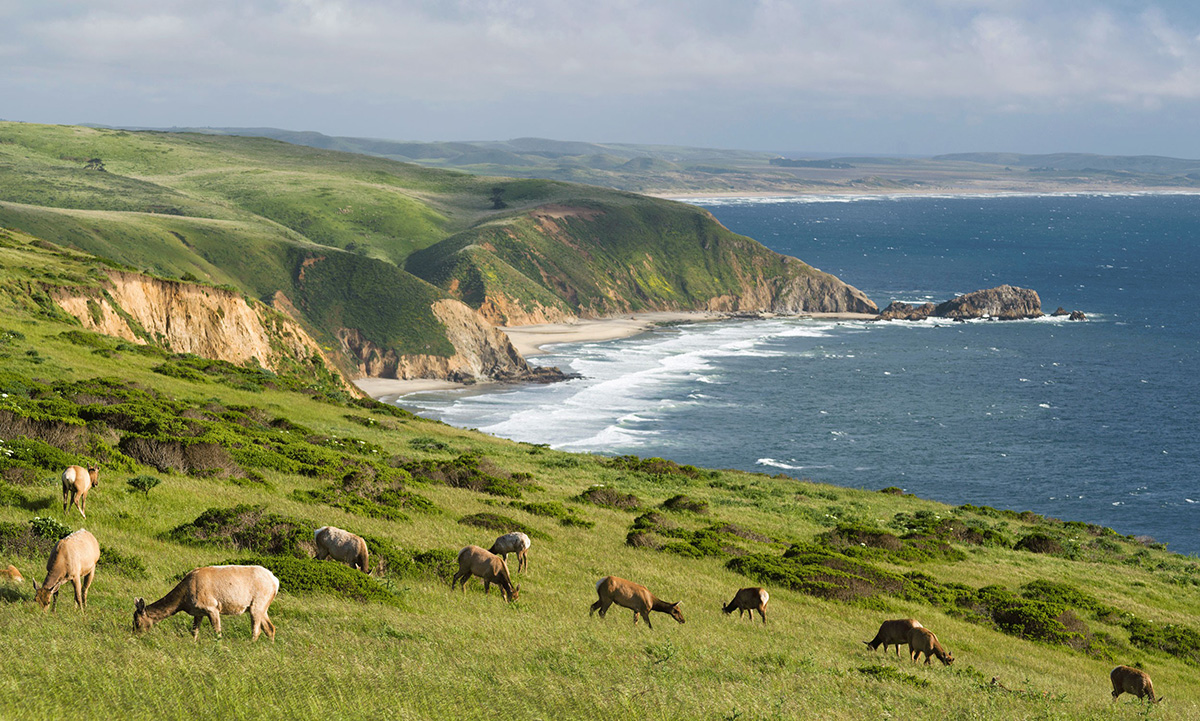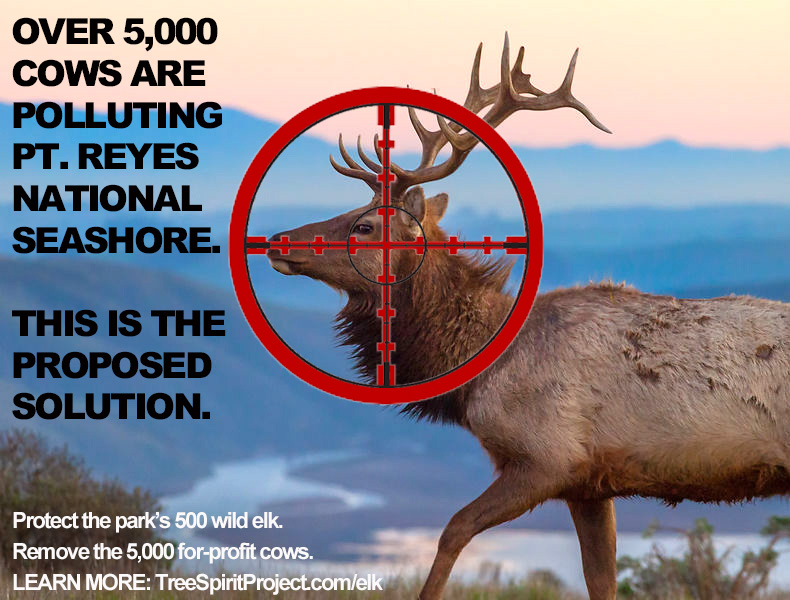JAN. 2025: Historic deal signed to end most ranching at Point Reyes National Park.
And finally, permanently, allow wild Tule elk to roam freely.
 January 8, 2025: The National Park Service has announced they have brokered a deal to remove thousands of cows — most beef cows and ALL the park’s dairy cows — from Point Reyes National Seashore.
January 8, 2025: The National Park Service has announced they have brokered a deal to remove thousands of cows — most beef cows and ALL the park’s dairy cows — from Point Reyes National Seashore.
And also permanently free the hundreds of elk inside the formerly fenced Tule Elk Reserve in northernmost Point Reyes, and allow all 3 of the park’s herds to roam, mix and mate as wild animals should have always been allowed to inside this national park unit.
WATCH: Sky-Jack Podcasts (VIDEOS) about this major step forward: https://www.TreeSpiritProject.com/podcasts
Partial Elk Fence Removal – CBS-TV News VIDEO – Wed., Dec. 5th, 2024
Big changes happened the week of Dec. 2nd-thru-6 (2024) at the fenced Tule Elk Reserve at Point Reyes National Seashore, a national park unit 20 miles north of San Francisco.
An 850-foot section of a 2-3-mile long, 8-foot-tall barrier fence — unnatural and deadly in a national park — was finally cut down by the Park Service this week, so a few more Tule elk could roam freely… and the cattle industry immediately filed a lawsuit against the National Park Service for daring to favor wild animals over their private, profit-driven industry… it’s already subsidized, clandestinely, with millions of taxpayer dollars.
Jack Gescheidt of the TreeSpirit Project and professional photographer Matthew Polvorosa-Kline spoke with CBS-TV KPIX reporter John Ramos about the latest news with the Tule Elk Reserve fence – – and this story is changing fast…
The NPS (National Park Service) announced its “Final Decision” to remove the fence (12/2) and began work quickly (12/3-4) perhaps out of fear of the looming Washington D.C. administration change which could be anti-wildlife pro-ranching. (Because they two are diametrically opposed.)
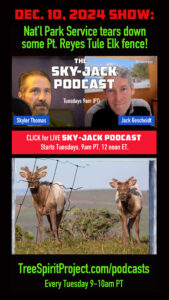 But one day later (12/4), the California Cattlemen’s stuck its Ass-ociation into the issue, filing a lawsuit to stop the Park Service from implementing its pro-environment, pro-wildlife, free-roaming elk decision.
But one day later (12/4), the California Cattlemen’s stuck its Ass-ociation into the issue, filing a lawsuit to stop the Park Service from implementing its pro-environment, pro-wildlife, free-roaming elk decision.
All this legal drama demonstrates why raising cows for meat & dairy — including on local, family-owned, organic-certified small farms (like these in Point Reyes) are worse than giant feedlots! Small farms pollute land, water, and air, and kill millions of wild animals in America — even in National Parks!
LEARN MORE: about the (false) promise of Regenerative Ranching.
WATCH: Sky-Jack Podcast #5 – Elk Fence Partially Down, Elk Taste Freedom!
CA Coastal Commission approves Park Service plan to free Elk from fenced Reserve.
Sept 12, 2024: The fenced elk herd at Point Reyes clears one more bureaucratic hurdle.
Read blogpost about how the largest of the seashore park’s three Tule elk herds — over 300 elk — is closer than ever to finally being freed from their 2,600-acre compound, to have access to tens of thousands more acres of this national park (which is overrun with private, for-profit cattle). They may soon, finally, have the ability to roam for more water and forage, and mingle and mate with elk in the park’s other two herds: https://treespiritproject.com/elk/ccc-approves-fencedown/
• Tule elk await release from deadly “Reserve”
• 2 pending lawsuits stall renewal of 20-year leases for private, polluting cattle ranches
• Shooting (“culling”) Tule elk for ranchers, by Park Service, on hold due to lawsuits
As of May 2024, all the Tule elk at Point Reyes National Seashore have enough water and food, due to a rainy winter season. But a hot, dry 2024 summer and autumn could again dry out the deadly, so-called “Tule Elk Reserve” at Tomales Point in the park. The herd trapped inside, the largest of 3 herds in the park, can’t roam outside its 2,600 acres onto this national park’s full 71,000-acres.
Why are these (or any) wild animals fenced off in a national park? Because politically powerful, privately-owned, for-profit dairy and beef ranches have corrupted park policies for decades. The profits of cattle operations, already heavily subsidized by taxpayers, are favored over the health of wild animals which suffer in myriad ways from filthy cattle operations which degrade land, streams and air.
The cattle ranches are also the Seashore’s #1 source of pollution; contaminating 28,000 acres of land, and numerous park streams and beaches which drain into the Pacific Ocean. Approximately 4,500 cows outnumber the park’s approximately 500 elk (in three separate herds) by about 9:1. As a result of being unable to reach more food and water during seasonal summer-autumn heat and drought, over 475 of the vulnerable tule elk have died in the last decade.
READ a February 2024 BLOG UPDATE about all the pending issues re. elk & cows at the Seashore.
CITIZEN ACTIVISM WORKS
For years, hundreds of wildlife and environmental activists have staged demonstrations inside the park and beyond, educated the public, alerted the news media, and spurred the federal government (the NPS, a division of the U.S. Department of the Interior) to change its policies. This citizen work continues into 2024 and beyond.
VIDEO | CBS-TV News: Park Service proposes dismantling deadly elk fence – June 19, 2023
Both pro-private-cattle ranchers and pro-wild-elk activists were surprised by the National Park Service’s formal proposal — subject to a Public Comment period and then either approval or retraction — to dismantle the controversial 3-mile-long, 8-foot-tall Tule Elk Reserve fence. Watch CBS-TV News Story:
https://www.youtube.com/watch?v=XY1q8qOF3FA
2023: About 262 elk inside fenced “Reserve”
Over 475 of the Tule elk inside the fenced “Reserve” have died in the last decade.
Point Reyes Seashore’s wild elk are fenced for only one reason: at the request of the park’s privately-owned cattle and dairy operations — which merely lease this park’s public land from the federal government at bargain-basement prices, about 1/2 their market value. Paid for via public subsidies. Hence these cattle businesses refusing to leave the park despite being paid, in the 1960s and 1970s, the equivalent of $350,000,000 in today’s dollars.
Ranches are also the park’s biggest polluters. These privately owned businesses, renting public land from a national park, have just been given new 20-year interim lease (while the Park Service is challenged by two separate lawsuits challenging the ranches harmful effec).
In addition, dozens of the elk who live outside the fenced Reserve can be shot (“culled”) by the Park Service when their herd size exceeds an arbitrary limit set at the behest of cattle ranchers. New Park Service rules allow elk “management” by rifle inside a National Park. The Park Service has said they have no immediate plans to shoot elk, but activists have learned from bitter experience that the Park Service does not always announce its actions in advance. Especially actions disastrous for public relations… like shooting wild elk in a national park unit.
All 3 of the park’s Tule elk herds are denied freedom to access to its 71,000 acres. 1/3rd of the park — 28,000 acres — is fenced off from both elk AND humans to accommodate beef and dairy operators only leasing land from the public. Millions of annual visitors are also cut off from a third of this public oceanside national park unit.
Numerous anti-wildlife policies of The National Park Service blatantly prioritize the for-profit, private cattle operations, and now allow the shooting some of the rare Tule elk on rancher’s behalf. America’s national park charter to protect wildlife and wild habit from commercial interests and industry pollution (in this fecal bacteria) is being blatantly ignored.
The approximately 500 rare, native Tule elk at Point Reyes National Seashore are not really wild here in this 71,000-acre national park unit just 20 miles north of San Francisco, CA. One of the park’s three herds is perennially suffering and dying from being held in captivity, behind cattle fencing built and maintained at the request of private cattle ranches leasing land in this public park.
You can help free and protect the magnificent Tule (“TOO-lee”) elk by sharing this page and its information. Public awareness of the elk’s plight — and the cattle industry’s pollution of this national park unit — has mushroomed in recent years, but needs to expand to pressure politicians to counter the powerful ranching lobby which calls the shots at Point Reyes.
The cattle industry has corrupted the national park’s mission to prioritize wild animals and undeveloped wildlands over the profits of private industry. At Point Reyes, the welfare of cattle operations come first. The park’s Tule elk are fenced off from 28,000 acres of leased cattle lands — fully 1/3rd the entire park — even though the land belongs to the public. In 1962, when this park was created, ranchers sold their land to the federal government for millions of dollars, but have since reneged on the deal to leave by 1987.
The movements of approximately 500 surviving Tule elk remain restricted inside Point Reyes park by a variety of cattle fences — with deadly results. Each year Tule elk suffer and die from inadequate forage (vegetation) and thirst in California’s seasonal summer-autumn drought.
Over 1/2 the Tule elk inside its so-called “Tule Elk Reserve” died in just two seasons, from 2019-to-2021. Simultaneously, about 5,000 privately-owned cows in the park are given exclusive use of 28,000 acres of this public park. Even the public is denied access to this 1/3rd of their park.
VIDEO: Deadly effect of fences on the Tule elk
Over 475 Tule Elk have died in the last 10 years, as a result of being trapped inside the fenced Tule Elk Reserve at Point Reyes, the largest of three herds in the park. This short (under 2 minutes) video shows just one of them: https://www.youtube.com/watch?v=T46aQFTq76A
The beef and dairy cows overgraze, trample and denude the land. And coat it with excessive manure — about 8,000,000 gallons of feces and urine every year. This huge amount of cow manure has for decades been polluting the parks’ streams, estuaries, bays and the Pacific Ocean. Two years of new surface water testing in 2021 and 2022 — conducted by citizen activists — NOT the National Park Service which ceased damning water testing in 2013 — revealed unsafe levels of fecal indicator bacteria like E coli, fecal coliform, and enterococci in the park’s waterways.
The untreated manure and urine are the park’s #1 source of water pollution. READ THE COW-POOPY WATER REPORT.
The cattle industry’s approximately 5,000 cows at Point Reyes are also the park’s #1 source of greenhouse gas (methane) pollution, exceeding the tailpipe emissions of the park’s annual 1-2 million annual visitor vehicles.
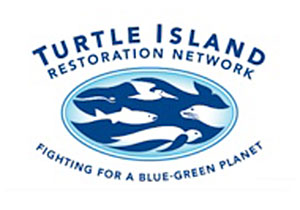 New Study Finds Significant Water Pollution from Cattle Ranching at Point Reyes National Seashore
New Study Finds Significant Water Pollution from Cattle Ranching at Point Reyes National Seashore
By Scott Artis, April 31, 2022
Photo© Sarah Killingsworth.com
EXCERPTS:
The most rigorous independent water quality report ever conducted in Point Reyes National Seashore has just been released by Turtle Island Restoration Network—and reveals water pollution dangerous to public health and the environment persists at the Seashore. The report… documents consistent and significant water quality pollution in this National Park unit caused by subsidized private ranching.
Point Reyes is one of a dwindling handful of national parks that allows cattle ranching. Ranchers lease 28,000 acres, more than one-third of the National Park Service’s land at Point Reyes, where they graze 5,000 beef and dairy cattle.
“The degree of pollution is astounding, especially considering it is occurring on the California coast and in a National Park,” said Scott Webb, Advocacy & Policy Director with the Marin-based Turtle Island Restoration Network. “I don’t care if it’s commercial agriculture or natural gas development, we need to stand up to private industry that continues to profit off destroying public land, hard stop.”
The study revealed that wading, swimming, kayaking, and other forms of water recreation in Kehoe Lagoon and Drakes Estero results in unacceptable health risk, as does shellfish harvesting in Drakes Estero. The study identified discharge of cattle manure as the cause of the pollution.
 The Cows That Ate Point Reyes
The Cows That Ate Point Reyes
By George Wuerthner, April 29, 2021
Photo: Jack Gescheidt, TreeSpiritProject.com
EXCERPT:
Fences. Everywhere I went during a recent trip to Point Reyes, I encountered fences. Why are there fences in a national park unit? They exist to facilitate the private use of public lands for a personal profit with the full blessing of the Point Reyes National Seashore administration.
Fences are symbolic of the controversy surrounding this park area. There are over 300 miles of barriers in the park. The controversy surrounding private ranching in a national park illustrates the problems created when personal profit and “cultural” preservation trumps the other values [which] national parks are supposed to preserve.
Livestock grazing in the park significantly degrades natural values, which the NPS is supposed to protect. This includes damage to streams, pollution of waterways, and harm to native fauna and flora.
READ ARTICLE: https://www.counterpunch.org/2021/04/29/the-cows-that-ate-point-reyes/
VIDEO: Public hauls in water to elk dying of thirst
– John Ramos, CBS-5 KPIX TV – Aug 28, 2021
VIDEO: Over 90 volunteers hiked 6 miles of dirt trail, hauling hundreds of gallons of water, to save the lives of the rare Tule elk trapped inside the drought-stricken “Tule Elk Reserve” at Point Reyes National Seashore. The National Park Service has prioritized protecting private cattle businesses by confining elk behind fences — so they can’t reach water and food.
CBS-5 TV News VIDEO: https://www.youtube.com/watch?v=ItSArqvtU60
 ‘The Situation is Dire’: California’s Tule Elk Face Biggest Threat Yet
‘The Situation is Dire’: California’s Tule Elk Face Biggest Threat Yet
By Ingrid Taylor, Sentient Media | January 20, 2022
EXCERPTS:
Jack Gescheidt, founder of The TreeSpirit Project and tule elk campaigner for In Defense of Animals, asserts that the Park Service’s continued reluctance to intervene on behalf of the elk supports the interests of the agriculture industry and not conservation. As he points out, “the Park Service has killed half the elk at Tomales Point in just two seasons.”
On January 5, [2022] the Animal Law & Policy Clinic at Harvard Law School filed another legal brief on behalf of the tule elk, part of a lawsuit that has stretched over several months and seeks to force the Park Service to take action to save the remaining elk. A key issue is the General Management Plan for the elk of Tomales Point, which the Park Service has neglected to update for 41 years.
This plan has not only failed to account for changing environmental conditions that impact the elk but also keeps the Tomales Point herd penned behind a fence at the tip of the peninsula. The fence prevents the elk from ranging beyond the 2,600-acre area of confinement to find year-round food and water sources.
READ Sentient Media ARTICLE:
https://sentientmedia.org/the-situation-is-dire-inside-the-fight-to-save-californias-tule-elk
2nd Lawsuit Challenges Ranching and Elk-Killing Plan at Point Reyes
Center for Biological Diversity | January 10, 2022
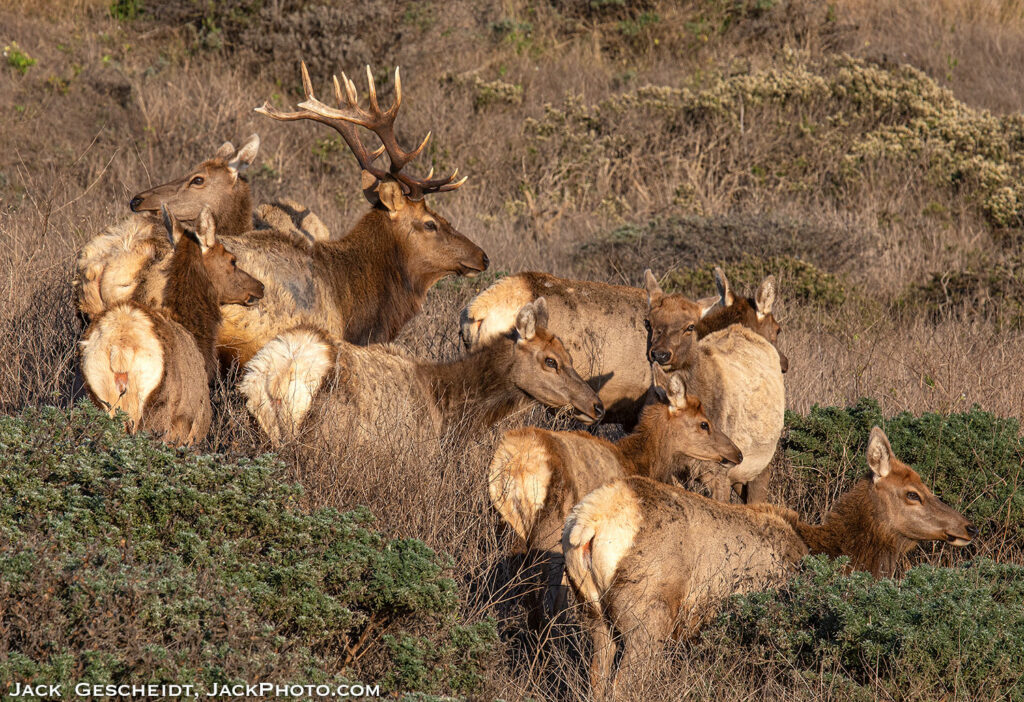
EXCERPT:
Three conservation groups today [1.10.22] filed a federal lawsuit challenging the National Park Service’s controversial management plan for expanding private agriculture at California’s Point Reyes National Seashore…
“This plan is a giveaway to the cattle industry,” said Deborah Moskowitz, president of the Resource Renewal Institute. “It perpetuates decades of negligence by the very agency charged with protecting this national treasure. The Trump administration fast-tracked the plan without regard for the climate crisis or the hundred rare, threatened and endangered species that depend on this national park. One-third of the national seashore is fenced off from public use.”
“The Park Service has long mismanaged Point Reyes by allowing ranchers to use and abuse the park for private profit,” said Jeff Miller with the Center for Biological Diversity. “Now the agency wants to treat our beloved tule elk as expendable problem animals to be shot or removed. Point Reyes belongs to the public, not a handful of ranchers.
READ CBD Media Release: https://biologicaldiversity.org/w/news/press-releases/lawsuit-challenges-point-reyes-ranching-elk-killing-plan-2022-01-10
How The Park Service Sold Out Point Reyes National Seashore
By Erik Molvar | September 29, 2021
EXCERPT:
“Thirteen ranchers won a sweeping victory this week, defeating the interests of 3,000,000 annual visitors to Point Reyes National Seashore, by securing a plan amendment that extends their commercial livestock operations on Park lands for at least 20 years.
The plan amendment — the first epic public lands fail by the nascent Biden administration — sells out native ecosystems, rare wildlife, and the beachgoing public.
The plan extends beef and dairy operations well beyond the terms well Congressional intention for the Seashore’s establishment in 1962 which prescribed livestock leases for “a definite term of not more than twenty-five years, or, in lieu thereof, for a term ending at the death of the owner or the death of his or her spouse, whichever is later.””
READ CounterPunch ARTICLE: https://www.counterpunch.org/2021/09/29/how-the-park-service-sold-out-point-reyes-national-seashore-to-the-livestock-industry
National Park Service sued over new management plan for Point Reyes Seashore
By Ike Allen | January 12, 2022
EXCERPTS:
A coalition of 3 environmental groups has again sued the Point Reyes National Seashore, this time over its newly amended general management plan. The same nonprofits whose 2016 lawsuit spurred the update to the plan are now hoping to reverse the park’s decision to extend ranching leases and allow the culling of free-ranging tule elk.
“The systemic problem is that the park service has let themselves be cowed by the ranchers and their allies,” said Jeff Miller, a senior conservation advocate at the Center for Biological Diversity, a plaintiff in the case. “They don’t manage the park for public interests and natural resources.”
READ Point Reyes Light ARTICLE: https://www.ptreyeslight.com/news/park-sued-over-gmpa
National Park Service Capitulated to Point Reyes Ranchers
By George Wuerthner | September 16, 2021
EXCERPTS:
The final Record of Decision (ROD) on livestock operations management at Point Reyes National Seashore was released this week. Unfortunately, and as feared, it not only maintains the ongoing degradation of this national park unit by privately owned domestic livestock, but it expands the opportunities for a handful of ranchers to do even more damage to the public’s landscape with additional lands opened for grazing, as well as the planting of row crops.
…The final management plan proposes to kill the native Tule elk if their populations grow beyond what the ranchers believe (as the NPS jumps to) is undesirable. The public submitted some 50,000 comments opposed to continued ranching and the killing of rare native Tule elk.
READ National Parks Traveler ARTICLE:
https://www.nationalparkstraveler.org/2021/09/op-ed-national-park-service-capitulated-point-reyes-ranchers
ELK & NATIONAL PARK ACTIVISM @ WORK:
Volunteers Bring Water to Elk Dying during Drought – John Ramos, CBS-5 KPIX TV – Aug 28, 2021
Over 90 volunteers hiked 6 miles of dirt trail, hauling hundreds of gallons of water, to save the lives of the rare Tule elk trapped inside the drought-stricken “Tule Elk Reserve” at Point Reyes National Seashore. The National Park Service has been slow to act, instead protecting private cattle businesses by confining the elk so they can’t reach water and food — inside a national park.
By the Park Services’s own annual counts, 406 of the native have died in the last decade; 152 in 2020 alone. They are struggling to survive.
WATCH CBS-5 VIDEO: https://www.youtube.com/watch?v=ItSArqvtU60
Point Reyes elk “prisoners” blocked from freedom by fence – Dan Noyes, ABC-7 TV, July 3, 2021
Over 70 demonstrators escorted a gang of 12 orange jumpsuit-wearing “prisoners” on a 1.2-mile walk to attempted freedom, inside Point Reyes National Seashore’s deadly, fenced “Reserve” enclosure that has killed over 406 Tule elk in the last decade. Blocked from reaching most of the park’s 71,000 acres, elk are dying from starvation and thirst.
National Park Service policies favor private cattle over Tule elk trapped inside the deadly drought-stricken “Reserve”— which the sign in the video above labels a “Penitentiary.”
WATCH ABC-7 VIDEO: https://abc7news.com/tule-elk-deaths-protest-endangered/10860141/
Elk are slowly dying from thirst and hunger — August 2021.
In June of 2021 the National Park Service finally brought in water troughs for some of the elk trapped inside the lethal, drought-stricken “Reserve” — but 3 of the 4 herds in the fenced Reserve still lack adequate water and forage (edible vegetation) too.
The effective way to end Tule elk deaths is to release them from their 2,600-acre zoo-like enclosure so they can access all 71,000 acres of this national seashore, where more food, water and healthy movement and mating await. Freedom of movement is essential for wild animals in a national park.
This is deadly wildlife mismanagement inside a national park. Elk are confined only at the request of private cattle operations leasing the public land at the Seashore. So both the cattle business, and their de facto proxy, The National Park Service, are responsible for hundreds of elk deaths in recent years, as well as methane emissions and massive fecal pollution of land, waterways, and ocean.
National Park Service ordered to attend emergency federal court hearing on Tule elk issue. – ABC-7 TV News
EXCERPT: “Everybody knows that California is enduring a record-breaking drought right now, and this is only June,” Environmentalist Jack Gescheidt told the I-Team’s Dan Noyes.
“It’s not even July yet. We have July, August, September, October, November. All that’s drought, and there are elk dying right now for lack of food and water.”
Gescheidt is one of the plaintiffs in a lawsuit filed by the Harvard Animal Law and Policy Clinic against the National Park Service, asking the judge to order “immediate measures” to supply “adequate food and water”.
VIDEO: https://abc7news.com/tule-elk-deaths-protest-endangered/10838764

406 Tule elk have died in the Reserve from 2012-to-2020.
The Park Service idly watched as 152 elk — 1/3rd the entire herd — died in the Elk Reserve in 2020… a slow, miserable death by thirst and/or starvation. Another 254 died while the Park Service stood by during the droughts of 2012-15. 254 + 152 = 406.
And in December of 2021, the Park Service quietly revealed on its website that an additional 72 Tule elk died in 2021 = 478 Tule elk dead (or not born) due to thirst and starvation in 10 years. 50% of all the Tule elk in a national park’s Reserve have been killed by Park Service “management” policies fencing them off inside a drought-stricken compound.
The Park Service calls these forced, fenced die-offs “natural population declines” — ignoring the reality that a manmade fence is anything but “natural.”
In fact, these are artificial and brutal population control tactics. Why? Because outside the 2,600-acre Reserve’s 8-ft-tall fence, privately-owned, for-profit cows eat and drink their fill on 18,000 acres of public parkland, and ranchers don’t want elk having any of it. Even though these are all public lands.
The land that ranchers occupy is rented from the park at half market rates. The public is subsidizing shrinking meat and milk businesses — the same businesses which are Point Reyes’ greatest source of land, water and air pollution.
 READ “Death by Design: How the National Park Service experiments on Tule elk”- A chilling expose by investigative journalist Peter Byrne’s June 30, 2021 chilling expose in The Pacific Sun: https://pacificsun.com/death-by-design-how-the-national-park-service-experiments-on-tule-elk/
READ “Death by Design: How the National Park Service experiments on Tule elk”- A chilling expose by investigative journalist Peter Byrne’s June 30, 2021 chilling expose in The Pacific Sun: https://pacificsun.com/death-by-design-how-the-national-park-service-experiments-on-tule-elk/
EXCERPT: The Pacific Sun/Bohemian has uncovered that the National Park Service at Point Reyes has killed tule elk, often in torturous ways, in medical experiments for decades. The federal agency absolves itself of any moral responsibility by blaming nature for the deaths. If only that were true.
BREAKING NEWS – June 23, 2021
Animal rights group sues park service over dying elk
 Marin Independent Journal article
Marin Independent Journal article
by Olga R. Rodriguez, June 23, 2021
EXCERPTS:
Dozens of tule elk at Point Reyes National Seashore have died from starvation and dehydration in the last year because the animals couldn’t get past a fence that the National Park Service placed to stop them from competing for food and water with cattle, according to a lawsuit filed Tuesday against the federal government.
Three California residents and the Animal Legal Defense Fund sued the park service in federal court in San Francisco claiming it is being negligent and more animals will die if the agency is not ordered to provide food and water during the drought.
Plaintiff Jack Gescheidt, an environmentalist and artist, has been visiting Tomales Point in the Point Reyes National Seashore for at least 20 years. He said the park service cited him after he took troughs of water to the elk.
“The knowledge that approximately a third of the Tomales Point herd of tule elk has already died from a lack of adequate water and forage is absolutely chilling,” he said. “I see these beautiful animals and want them to experience a healthy, happy, safe life, but I know that so many of them will die—through no fault of their own.”
Lawsuit: Point Reyes National Seashore negligent in tule elk die off
![]() Marin Independent Journal article
Marin Independent Journal article
by Will Houston, June 22, 2021
EXCERPTS:
Katherine Barnekow, an attorney at Harvard’s Animal Law and Policy Clinic, said the park’s management of the herd is “undeniably inhumane” and that its delayed response to the lack of food and water “has become so harmful and dire that legal action needs to be taken.”
“To argue that a die off is somehow natural because of a manmade boundary — a fence, the complete opposite of a natural boundary — is just absurd,” Barnekow said. “It’s cruel and the fact they’ve gotten away with it for this long is a problem. I’m hoping our plaintiffs and this legal action will do something to address that sooner rather than later.”
“Setting aside the ecological devastation of the Seashore by the cattle industry, the Park Service’s treatment of the Tule elk is a brutal betrayal of their legislated mission,” Gescheidt wrote in a statement on Tuesday. “They’re legislatively required to protect what are called ‘the natural resources’ of Point Reyes Seashore, a national park unit, above other considerations. But that’s not happening. On the contrary, the interests of private cattle ranches and dairies are being prioritized.”
The Interior Department did not respond to a request for comment by Tuesday afternoon.
https://www.marinij.com/2021/06/11/drought-point-reyes-supplies-emergency-water-for-tule-elk/
After claiming 152 Point Reyes elk died from lack of food, not water, Park Service provides water, but not food.
![]() Marin Independent Journal article
Marin Independent Journal article
by Will Houston, June 11, 2021
EXCERPTS:
Gescheidt said while the water troughs will save the lives of some elk, their main issues are not addressed.
“I find it ironic that they’re providing water when they have been saying all along that there was adequate water but inadequate food,” Gescheidt said. “So what are they going to do about the food?”
Activists such as Jack Gescheidt of the TreeSpirit Project, who have been calling for the park to install water troughs in the preserve for months, welcomed the announcement.
“Fantastic. Great to hear,” Gescheidt said. “It’s what we’ve been saying they should have done for over a year so that 152 elk didn’t die unnecessarily last year based on their own count. It’s a great temporary fix but more elk will still die because of inadequate food in the elk penitentiary.”
https://www.marinij.com/2021/06/11/drought-point-reyes-supplies-emergency-water-for-tule-elk
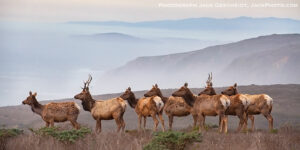
Join our mission of mercy to free these magnificent rare elk that are SUPPOSED to be free in a national park.
Join a growing community of elk, wildlife, and National Park protectors — including In Defense of Animals, PETA, ForElk.org, the Sierra Club and Patagonia — who demand wildlife at Point Reyes National Seashore be free, not fenced, starved or shot f0r private, for-profit ranches and dairies, which have no business inside a national park. READ UP on the ISSUES.
• READ UP ON THE ISSUES & join us 11am July 3rd, 2021. Share on social media.
• SIGN UP to be emailed re. upcoming events & demonstrations
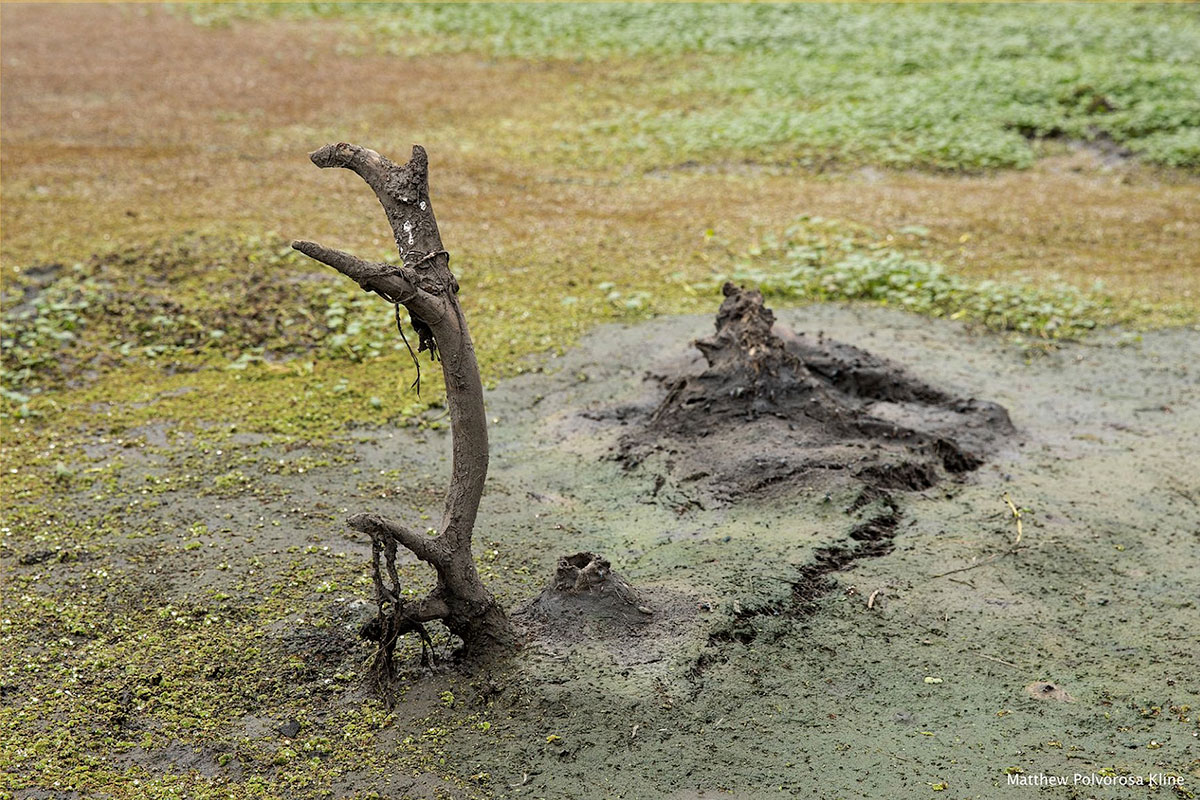
Elk deaths soar to 406 at Point Reyes Seashore in 2021. Trapped behind fences without adequate water or vegetation in California’s drought. Photo: Matthew Polvorosa Klein
152 Tule elk die of starvation and thirst in Point Reyes “Reserve” in 2020.
1/3rd the entire herd of captive, “managed” tule Elk, trapped inside the fenced “Reserve” died last year (2020) because they couldn’t roam for adequate food and water. Which means the elk died slow, painful deaths of starvation and dehydration.
Just as activists had repeatedly warned was happening, and photo-documenting, for months. All warnings of this ongoing, torturously slow-motion elk slaughter were ignored by the Park Service. Another 100+ elk are expected to die in this years’s (2021) summer-autumn drought, ongoing in California.
If 1/3rd an entire herd of 455 elk — now only 293 elk! — died in a private zoo, the operation would be brought up on charges of criminal animal neglect.
 READ Outside story by Patagonia founder Yvon Chouinard | May 13, 2021
READ Outside story by Patagonia founder Yvon Chouinard | May 13, 2021
https://www.outsideonline.com/2423817/yvon-chouinard-wants-protect-point-reyes
EXCERPTS:
For decades, beef and dairy ranching have been allowed on this national treasure through a series of agricultural leases and special permits, despite the environmental consequences: wildlife injuries and deaths, watersheds fouled by manure runoff, and methane-belching cattle that fuel the climate crisis.
…340 miles of barbed wire fences have fragmented habitat, impacted animal crossings, and deterred the general public from exploring nearly a third of their park. Then, late last year, the Trump administration upped the ante and put forth a controversial management plan to cement ranching operations at Point Reyes, giving commercial beef and dairy companies even greater control over a public park and its wildlife.
The National Park Service’s plan for Point Reyes would further degrade this natural sanctuary by permitting commercial row crops, additional types of farm animals (chickens, hogs, sheep, goats), mobile slaughter facilities, and the killing of native Tule elk to give cattle more grass to eat. All of it subsidized by the American taxpayer.
https://www.outsideonline.com/2423817/yvon-chouinard-wants-protect-point-reyes
VIDEO: “Point Reyes Wilderness in Peril”
A team of conservationists, biologists, filmmakers, and local leaders discuss how a national treasure is being devastated by private cattle industry pollution, habitat loss, and giveaways: https://www.youtube.com/watch?v=XDeldcRDEA8&t=181s
Los Angeles Times story – April 14, 2021


https://www.latimes.com/california/story/2021-04-14/scores-of-tule-elk-died-at-point-reyes-national-seashore
EXCERPTS:
Amid a dry 2020, the [animal rights] groups tried to bring water to the creatures [Tule elk] but were rebuffed by the National Park Service. Now the federal agency has released a report indicating that more than one third of the 445 elk fenced in at Tomales Point died this past winter, bringing the population down to 293 [a net loss of 152 elk, presumably by death by starvation and/or thirst].
…[surface water quality] tests revealed that E. coli levels at Abbotts Lagoon [below I-Ranch dairy inside Point Reyes National Seashore] were 20 times greater than what’s considered acceptable, and 40 times greater at Kehoe Lagoon [below Kehoe Dairy in the park]. E. coli is associated with fecal contamination…
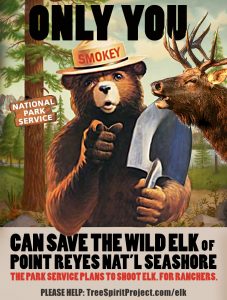 SAVE ELK FROM BEING KILLED by Park Service (!) at Point Reyes National Seashore:
SAVE ELK FROM BEING KILLED by Park Service (!) at Point Reyes National Seashore:
 READ: Elk Deaths Mount at Point Reyes Seashore, April 5, 2021
READ: Elk Deaths Mount at Point Reyes Seashore, April 5, 2021
By Susan Ives

Elk Deaths soar at Point Reyes Seashore. Trapped behind fences without adequate water or forage in drought. Photo: Matthew Polvorosa Klein
EXCERPTS:
The National Park Service (NPS) has revealed that 152 Tule elk recently died under its watch. [in 2020]
Last fall, park visitors and wildlife advocates alerted the NPS that water sources in the elk enclosure had dried up, offering photos of elk carcasses as evidence. The NPS dismissed them, insisting there was water. Some 250 elk—half the confined herd—died during the 2012-2015 drought…
…the NPS permits dairies to pump water out of park wetlands to supply cattle—no environmental impact analysis necessary.
READ : Elk Deaths Mount at Point Reyes Seashore By Susan Ives
Fecal Bacteria Poisons Point Reyes Beaches
By Peter Byrne, PACIFIC SUN, March 10, 2021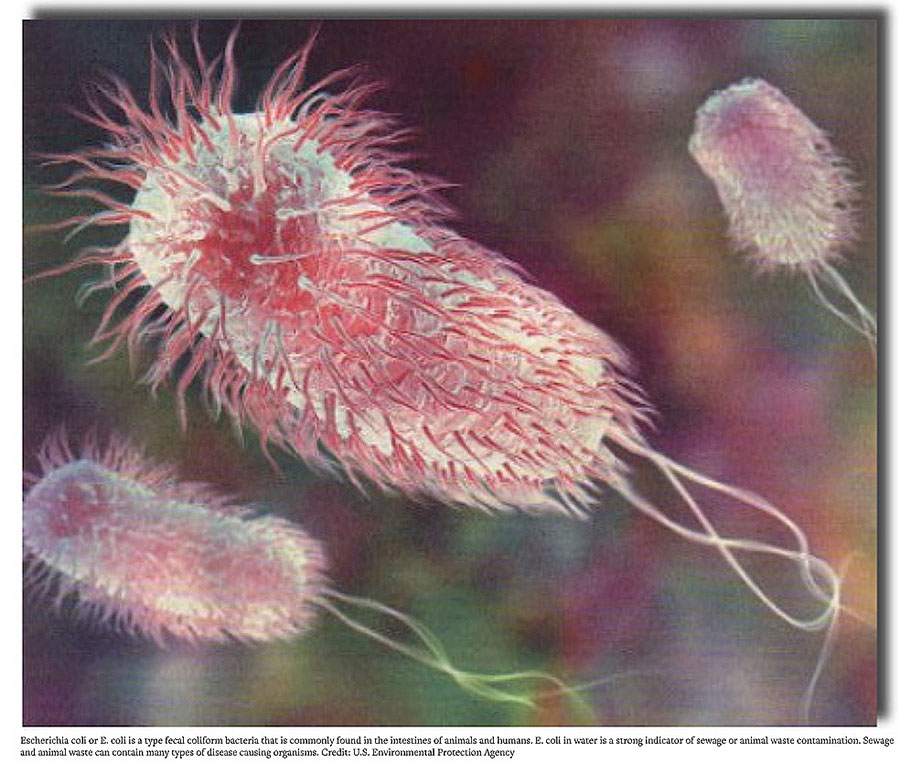
EXCERPTS:
In a January [2021] test of the water in Abbotts Lagoon [at Point Reyes National Seashore] an aquatic toxicology laboratory hired by environmentalists, the number of E. Coli cells found in water samples was 20x the safe amount.
At Kehoe Lagoon, the safety margin was exceeded by a factor of 40. It gets worse for E. Coli’s nasty bacterial cousin… Enterococcus. It can devour your heart, stomach, brain, and spinal cord. This monster thrives in raw sewage and intestines. Abbotts Lagoon contains 60x the safe number of Enterococcus, which is resistant to antibiotics.
READ Fecal Bacteria Poisons Point Reyes Beaches
Water Contamination from Cattle Ranching at Point Reyes Seashore Causes Outrage
MEDIA RELEASE: Western Watersheds Project, March 4, 2021
EXCERPTS:
Water sampling from Kehoe Creek and Abbotts Lagoon on January 27 and 28, 2021, showed that bacteria contamination of surface water dramatically exceeded water quality criteria despite the reported implementation by the park service of waste management actions in drainages impacted by dairy and beef ranches.
READ Media Release by Western Watersheds Project
VIDEO: “Cesspool by the Seashore”
Hazardous water pollution at Point Reyes
VIDEO explains 2021 water pollution-by-cow, in a national park unit:
https://www.youtube.com/watch?v=k_zN-pDFbzI
4 FACTS YOU DON’T KNOW
about Point Reyes National Seashore:
 FACT #1 – Ranches and dairies were paid $$ millions to leave Point Reyes by 1987 — then reneged on the deal.
FACT #1 – Ranches and dairies were paid $$ millions to leave Point Reyes by 1987 — then reneged on the deal.
Cattle and dairy ranchers collectively agreed, in 1962, to leave Point Reyes, and were paid the equivalent of $350 million in today’s dollars.
They were to transition off the land within 25 years (by 1987) to make Point Reyes a wild, pristine seashore in the National Parks system. Instead, they lobbied Washington for 5 and 10 year lease extensions. And continue to do so.
Now ranchers don’t want to leave at all. Worse, they have successfully lobbied the Park Service to expand operations, add goats and chicken, row crops, even commercial concessions.
FACT #2: Ranchers have pressured the Park Service to shoot elk.
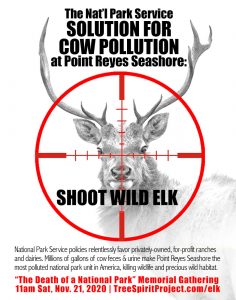 Ranchers, with the Park Service as their deadly proxy, want elk “culled” every year — shot dead — inside this National Park unit. Ranchers don’t want elk eating grasses, or drinking water, they want only for their 5,600 for-profit cows. And cows outnumber about 700 elk 8-to-1.
Ranchers, with the Park Service as their deadly proxy, want elk “culled” every year — shot dead — inside this National Park unit. Ranchers don’t want elk eating grasses, or drinking water, they want only for their 5,600 for-profit cows. And cows outnumber about 700 elk 8-to-1.
The practice of killing of wild animals to benefit private cattle ranchers is widespread and commonplace in America. Over 2 million wild animals are killed for ranchers every year in the U.S. Coyotes, foxes, wolves, scarce mountain lions, bear, bobcats, even crows are among species killed with Federal taxpayer dollars, for these private businesses. The agency doing the killing (shooting, trapping, poisoning) is a division of the USDA with an Orwellian name, “Wildlife Services.” CHECK IT OUT.
FACT #3: 5,600 cows are Point Reyes’ biggest polluter.
 Herds of 1,200-lb cows do massive soil compaction damage, and produce a huge amount of untreated feces and urine — 10-20 million pounds every year. Fecal contamination poisons the soil and run-off contaminates streams, ponds, Drakes Estero, Drakes Bay, Tomales Bay, and the Pacific ocean.
Herds of 1,200-lb cows do massive soil compaction damage, and produce a huge amount of untreated feces and urine — 10-20 million pounds every year. Fecal contamination poisons the soil and run-off contaminates streams, ponds, Drakes Estero, Drakes Bay, Tomales Bay, and the Pacific ocean.
AIR pollutants from cows, particularly their methane, exceeds the car emissions of the parks’ 2.4 million annual visitor’s vehicles.
FACT #4: Cows outnumber elk 8-to-1; approx. 700 elk; approx. 5,600 beef and dairy cows.
The elk have in recent decades recovered from near-extinction. There are fewer than 5,700 tule elk on Earth. They’re all in California. They are not listed as endangered or protected. And now the Park Service wants to shoot elk here inside Point Reyes, a national park unit.
JOIN future COMMUNITY ACTIONS:
Want to get out from behind a desk, use your feet, hands, body, voice and heart? TAKE ACTION outside in the natural world to help the elk, the environment and a national park!
Sign up with the green button above to be notified of upcoming actions and events you can participate in.
All demonstrations and actions are peaceful, organized, Covid-safe, and designed to gain media attention to inform the public of the critical Point Reyes issues which also have national, international and climate crisis significance.
 MORE ACTIONS YOU CAN TAKE TO HELP THE ELK, including contacting politicians & officials, are near the bottom of this lengthy webpage.
MORE ACTIONS YOU CAN TAKE TO HELP THE ELK, including contacting politicians & officials, are near the bottom of this lengthy webpage.
The Tule elk are only the largest, most visible Point Reyes wildlife species being threatened, harmed, and even killed by current NPS (National Park Service) policies which favor for-profit business operations in the park over the health of its land, water, plants, and animals. This is the opposite of what is supposed to be prioritized in a national park unit.
Point Reyes waterways are on “The Top 10% Most Polluted Waterways in America” list:
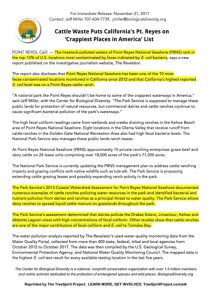
 READ “Crappiest Places in America” PRESS RELEASE from the Center for Biological Diversity.
READ “Crappiest Places in America” PRESS RELEASE from the Center for Biological Diversity.
EXCERPT:
Point Reyes National Seashore has been one of the 10 most feces-contaminated locations monitored in California since 2012…
[and]…California’s highest reported E. coli level was on a Point Reyes cattle ranch.
IN THE NEWS
Read blistering article: Apocalypse Cow
By Peter Byrne, Dec. 9, 2020
EXCERPTS:
Since 2013, Sen. Dianne Feinstein and Rep. Jared Huffman have pressured the Park Service to prioritize the preservation of private ranching profits over environmental concerns. In 2017, the Park Service hired a contractor with a record of defrauding the federal government to produce the EIS (Environmental Impact Study).
The study is structured to support the Park Service’s prior commitment to expanding commercial ranching, retailing and hoteling at the expense of endemic wildlife and plant life and regional water safety. It ignores the cumulative impacts of climate change. It minimizes and ignores the benefits of eliminating greenhouse gas- and pollution-producing ranching and transforming the park into a carbon sink.
On the cow side of the fence, the land is barren, churned into a gray dust by hooves and crusted with methane- and nitrogen-emitting manure.
READ in-depth article, “Apocolypse Cow” by Peter Byrne
 READ Bay Nature article:
READ Bay Nature article:
Point Reyes: Planning or Performance
By Ken Bouley, Jan. 7, 2021
EXCERPT:
“It is frequently claimed that ranching was meant to stay in the park from its inception. Representative Huffman describes the “historic ranches in the area Congress always intended to be a pastoral zone where our ranching heritage would be preserved.” But this claim is fraught with hearsay and self-interested bias. The definitive history of the Park, Managing a Land in Motion: An Administrative History of Point Reyes National Seashore, prepared for the National Park Service in 2007, summarizes as follows: “Legislators paid close attention to property owners’ rights, but the ranches and dairies were not elements that the NPS, park supporters, or legislators sought to protect as part of the larger national seashore idea.’”
READ, Bay Nature article by Ken Bouley
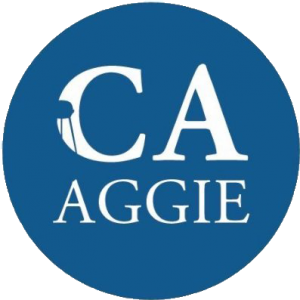 READ The California Aggie article:
READ The California Aggie article:
Point Reyes Seashore is One Step Closer to National Dairy Farm
By Joe Sweeney, Jan. 12, 2021
EXCERPT:
“The Dairy Industry at Point Reyes has often been hailed as the embodiment of sustainable ranching and resource management in California. Unfortunately, this narrative does not line up with the facts. The agriculture industry is one of the biggest contributors to climate change. In fact, livestock alone contribute 14.5% of total greenhouse gas emissions. The environmental impact statement addresses the impact of continued ranching in the peninsula, stating that under current conditions, roughly 24,500 metric tons of emissions will be produced annually. This is in sharp contrast to the carbon sink which Point Reyes and other national parks are often advertised as.
READ California Aggie article by Joe Sweeney
ACTIVISTS BRING WATER TO ELK… but the Park Service intervenes…
WATCH VIDEO: “Dying of Thirst”
By Silver Reaction Media, Dec. 8, 2020
Hyperlink: https://www.youtube.com/watch?v=ndXyAbe5rOg&t=1s
288 PEOPLE DEMONSTRATION,
“Live Elk, not Livestock”
Huge gathering @ Point Reyes National Seashore, Sept. 27, 2020
WATCH VIDEO of this biggest-yet event, by In Defense of Animals:
 READ Mercury News story: Environmentalists & animal rights activists demonstrate against plans for Point Reyes’ future.
READ Mercury News story: Environmentalists & animal rights activists demonstrate against plans for Point Reyes’ future.
By Elliott Almond, The Mercury News, 9.27.20
In response to the National Park Service announcing (9.18.20) its final plan for the future management of Point Reyes National Park — allowing more for-profit livestock and shooting (“managing”) wild elk every year, 288 citizens demonstrated to differ.
 READ The Wildlife News story: Welcome to Point Reyes National Cattle Ranch
READ The Wildlife News story: Welcome to Point Reyes National Cattle Ranch
By George Wuerthner, Sept. 30, 2020
READ ARTICLE HERE EXCERPT BELOW.
The decision to continue livestock production in Point Reyes National Seashore demonstrates once again why allowing any commercial resource use in our parklands compromises the primary goals of our park system—which is to manage public lands for public values, not private profit.
One of our national park systems’ primary responsibilities is to maintain native ecosystems, protect biodiversity, and minimize human inference in natural ecological processes. The Park Service’s preferred management alternative compromises all these goals to benefit a handful of ranchers who have been eating at the public trough now for decades. – George Wuerthner
READ Sept. 30, 2020 George Wuerthner’s Wildlife News article
HOW YOU CAN HELP ELK:
TAKE ACTION FROM HOME: contact politicians & officials @ bottom of page.
WATCH VIDEO: Congressman Huffman shocks Republicans (and us) with his advocacy for killing (aka, “managing”) wild elk at Point Reyes National Seashore.
LINK: https://www.youtube.com/watch?v=zXcEMlb6-ik&feature=youtu.be
ELK in the NEWS:
 VIDEO: Activists dramatize plight of elk trapped behind fences in CA drought at Point Reyes Seashore
VIDEO: Activists dramatize plight of elk trapped behind fences in CA drought at Point Reyes Seashore
ABC NEWS ARTICLE: https://abc7news.com/pets-animals/wildfires-impact-water-emergency-for-tule-elk-at-pt-reyes/6423115/
Wild elk at Point Reyes Seashore blocked from water. By cattle fences. In California’s drought. In a National Park.
2020 is a repeat-in-progress of the tragic death of the 254 elk who died of thirst in the 2013-to-2015 drought seasons when elk were fenced off from water sources and neglected by the Park Service.
Almost 1/2 the reserve’s population of 540 elk died because 8-foot tall fences prevent them from foraging for food and water in this National Park because private cattle ranchers lobby the Park Service to pen the elk.
WATCH ABC-TV VIDEO: https://www.youtube.com/watch?v= _w&t=4s

Trapped behind fences, elk were unable to reach water available to thousands of cows. The park service did nothing.
EXCERPT: Nearly half of the tule elk in a fenced preserve on the Point Reyes National Seashore died over the past two years, and a conservation advocate says he believes it’s because their water sources dried up and they couldn’t get outside their fenced enclosure to find more.
READ April 17, 2015 SF Gate article.
254 Elk Die of Thirst in Elk Range,
Point Reyes National Seashore
READ essay by retired Dept. of Interior attorney Jim Coda. 3.26.15
“The elk in the reserve are not free-ranging like the elk in the rest of the park. They are held captive behind an 8-foot tall woven wire fence. Thus they can’t seek out water at a time of drought when there isn’t enough water inside the enclosure.” – Jim Coda
![]() Elk advocates protest Point Reyes wildlife management
Elk advocates protest Point Reyes wildlife management
– Marin Independent Journal, Will Houston | Sept. 15, 2020
READ ARTICLE: https://www.marinij.com/2020/09/14/environmental-groups-protest-point-reyes-elk-management-on-anniversary
EXCERPTS:
“(The elk) will just quietly lay down and die if they don’t get enough food and water,” Gescheidt said on Monday. “Because they have put a fence up, they have in effect created a big zoo. And if you have a zoo you have to take care of the animals inside of it.”
“We really want to hold the park accountable to their negligence over management of wildlife,” Diana Oppenheim [of ForElk.org] said Monday. “We want to help educate the public that the National Park Service is prioritizing animal agriculture and cattle grazing over wildlife. We’re hoping to gather enough media, public pressure and attention so the park service does its job and protects the wildlife.”
Efforts to remove ranches go beyond the elk, Gescheidt said, by also addressing environmental impacts caused by cattle ranching such as greenhouse gas emissions.
“It’s a microcosm of what’s going on across America and the world,” he said, “which is the destruction of wildlands and the expansion of domesticated animals replacing forests and wildlife that are the life support system of this planet.”
![]() Activists ignore rules, bring water to fenced in elk during drought.
Activists ignore rules, bring water to fenced in elk during drought.
– The Point Reyes Light, Anna Guth | Sept. 2, 2020
READ ARTICLE: https://www.ptreyeslight.com/article/park-refutes-activists-claim-elk-lack-water
EXCERPT:
Despite statements by Point Reyes Nat’l Seashore officials that the tule elk herd within the fenced enclosure at Tomales Point have an adequate water natural water supply….
…around a dozen people took matters into their own hands, carrying buckets [bottles – Ed.] of water into the enclosure and filling troughs they brought with them.
 As fire burns, activists sneak into Point Reyes to bring water to parched elk.
As fire burns, activists sneak into Point Reyes to bring water to parched elk.
– Susanne Rust, L.A. Times, Sept. 1, 2020
LINK: https://www.latimes.com/california/story/2020-09-01/fire-point-reyes-tule-elk-water-activists
 Tule elk at center of epic conservation battle.
Tule elk at center of epic conservation battle.
– Shoshi Park, Roadtrippers Magazine
EXCERPT:
Despite being a national park site, Point Reyes is a key battleground for the future of conservation in California and at its center, the tule elk roam.
What caused the degradation is no mystery. Point Reyes National Seashore is one of only a few national park units that has allowed historic ranches and dairies to continue to work within its bounds and, along with them, more than 5,000 cows trample the soil and smother the pastures with their manure.
ARTICLE: https://roadtrippers.com/magazine/point-reyes-national-seashore-tule-elk
Another scuffle over Pt. Reyes elk — this time over water
San Francisco Chronicle, Sept. 1, 2020
READ ARTICLE: https://www.sfchronicle.com/bayarea/article/Another-scuffle-over-Point-Reyes-elk-population-15532010.php
EXCERPTS:
…activists used 40-pound jugs carried by hand from a truck to fill two steel troughs, said Jack Gescheidt, who participated in the clandestine nighttime water drop.
“When animals are enclosed, they have to be taken care of, because they can’t seek out what they need,” said Deborah Moskowitz, president of the Resource Renewal Institute…
…the unusual prevalence of elk carcasses may be a sign of more elk deaths to come. The park’s unwillingness to replenish the herd’s water represents a “disturbing replay” of the 2011-2015 drought that left 254 of 540 elk dead…
WATCH “Jane Unchained” INTERVIEW of elk activists
WATCH INTERVIEW of 5 Point Reyes elk activists
(incl. TreeSpirit’s Jack Gescheidt) by host Jane Velez-Mitchell. SEPT. 8, 2020
VIDEO: Tule Elk: The Killing of a Native Species
An 8 MIN overview of the elk vs. cows issues in Point Reyes – emblematic of the conflict between using land to mitigate the climate crisis, or exacerbate it by destroying wildlands (and wildlife) to expand GHG-generating, for-profit cattle operations. – Sept. 2020
TAKE JUST 30 SEC. – Join 22,000 people (as of Sept. 2020) showing politicians and fellow Americans that a majority of Americans want wild animals, not private livestock operations, in a National Park.
SIGN & SHARE on social media. https://www.change.org/p/cicely-muldoon-save-the-tule-elk
TAKE MORE ACTIONS AT BOTTOM OF THIS WEBPAGE.
MORE STARTLING, LITTLE-KNOWN FACTS:
• Over 5,600 privately owned, for-profit cattle graze on about 1/3rd of the 71,055 acres of public land comprising Point Reyes National Seashore (PRNS), a National Park in westernmost Marin County, CA, in the San Francisco Bay Area.
• These beef and dairy cows comprise the largest commercial cattle operations inside any American National Park, of any size. The ranchers now want to expand their operations to include pigs, goats, sheep, chickens, turkeys and row crops. And even concessions stands. All to prop up the declining profitability of beef and dairy, even when leasing Pt. Reyes land at under-market value.
• Your federal taxpayers dollars subsidize these private businesses in a national park — and massively pollute its land, air, and water.
• And ranchers are now, in 2020, lobbying the National Park Service (NPS) to kill scores of wild tule elk each year which have only recently been re-established in the park, back from the brink of extinction. In 1978, there were only 25 elk in all of California.
Q. Why do ranchers want wild elk shot?
A. They don’t want elk grazing land or drinking water they want exlusively for their over 5,600 beef and dairy cows — about 10x the elk population. Note that the average elk weighs 400 lbs. while the average cow weighs 1,300 lbs. To maintain their weight (3x that of elk), the cows eat more, and pollute more of Pt. Reyes’ air, soil and water with their untreated manure. (Read more about cattle pollution, below.)
WATCH 2 MIN. VIDEO: Point Reyes Poop-Off (Comparison): elk vs. cows by filmmaker Skyler Thomas.
Remember, Pt. Reyes is a National Park, created to offer the greatest protections for America’s wild animals and remaining wild lands — not support private, for-profit businesses. Dairy and beef operations were supposed to have ended in 1987, but ranchers have successfully lobbied the park service (NPS) for 5 and 10 year lease extensions ever since. Now they want a 20-year lease extension, to bring in more cows, to bring in sheep, goats, pigs and chickens. And to shoot elk — what ranchers call “culling” and politicians call “management” — every year as they deem necessary.
Privatization of public lands is the ongoing ecologically devastating trend in America. Killing Pt. Reyes wild elk is only a new, more obvious offense. Ranching on its mega, modern scale denudes and pollutes the air, the soil, and waterways.
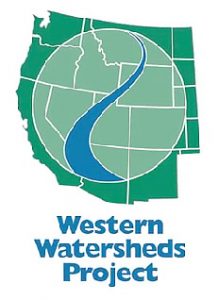 READ “The Ecological Costs of Public Lands Ranching” – Ranching is the most widespread use of public lands in the U.S., a primary cause of wild plant and animal species endangerment in the West, and the largest cause of non-point source water pollution and desertification. READ Western Watershed Project: https://www.westernwatersheds.org/public-lands-ranching
READ “The Ecological Costs of Public Lands Ranching” – Ranching is the most widespread use of public lands in the U.S., a primary cause of wild plant and animal species endangerment in the West, and the largest cause of non-point source water pollution and desertification. READ Western Watershed Project: https://www.westernwatersheds.org/public-lands-ranching
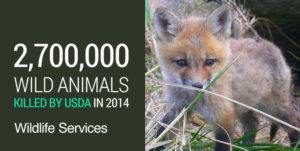 In addition, and perhaps most disturbing, the federal government’s USDA “Wildlife Services” kills over a million wild animals every single year — including foxes, bobcats, coyotes, wolves and mt. lions — at the behest of private ranchers across America, especially in the west. Wildlife (killing) Services is a macrocosm of what Pt. Reyes ranchers want to do with their neighboring wildlife.
In addition, and perhaps most disturbing, the federal government’s USDA “Wildlife Services” kills over a million wild animals every single year — including foxes, bobcats, coyotes, wolves and mt. lions — at the behest of private ranchers across America, especially in the west. Wildlife (killing) Services is a macrocosm of what Pt. Reyes ranchers want to do with their neighboring wildlife.
LEARN MORE about Wildlife Services killing millions of wild animals:
• National Geographic: https://www.nationalgeographic.com/news/2016/02/160212-
Wildlife-Services-predator-control-livestock-trapping-hunting
• The Revelator: https://therevelator.org/killing-wildlife-services
• This website’s Wildlife Services expose page.
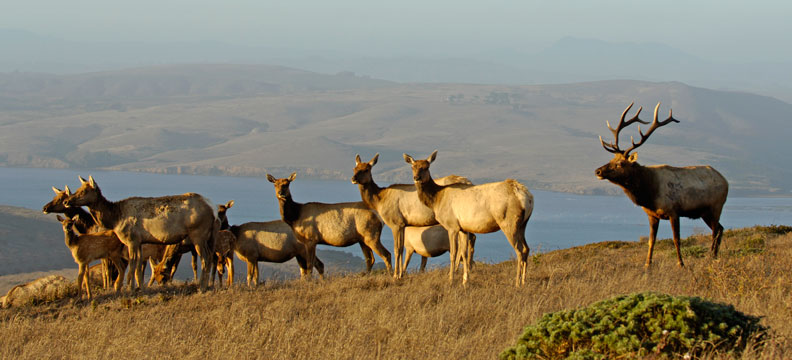
Pt. Reyes’ tule elk, back from the brink of extinction, now face death-by-cattle-ranchers. Photo by Gary Al
The elk herd has grown from a small herd of just 25 re-introduced in 1978. In 2019 their dramatically increased numbers are still only 1 elk for every 10 cows in the park. The elk are a rare wildlife success story, having been successfully brought back from the brink of extinction, especially in our modern era of mass extinctions. More tule elk now live on the Pt. Reyes peninsula than anywhere in the world. (About 4,000 tule elk live in various ranges in California. But an estimated 500,000 elk roamed free when Europeans arrived.)
National Parks are supposed to have the highest level of environmental and wildlife protection afforded any American lands. But 1,300-lb. cows are, by their very nature, Point Reyes’ major source of land, water, ocean and air pollution (elk weigh only 1/3 as much, about 400 lbs.):
1) Cows are the biggest polluters of Pt. Reyes’ land with their untreated excrement — over 130,000,000 lbs. every year. The highest measurement of E. coli bacteria contamination from feces, in all of California, was on a Point Reyes cattle ranch.
2) Cows are the biggest polluter of Pt. Reyes’ waterways; its streams run-off into the adjacent Pacific Ocean — Point Reyes ranks in the top 10% of U.S. waterways contaminated by feces;
3) Cows are the biggest polluter of Pt. Reyes’ air. A Park Service study determined that methane from the cows comprised “the vast preponderance” of Pt. Reyes’ greenhouse gases (GHGs).
 READ MORE about cow pollution in Center for Biological Diversity press release.
READ MORE about cow pollution in Center for Biological Diversity press release.
EXCERPTS:
PRNS has been one of the 10 most feces-contaminated locations monitored in California since 2012 and that the state’s highest reported E. coli level was on a Pt. Reyes cattle ranch.
The Park Service’s 2013 Coastal Watershed Assessment for PRNS documented numerous examples of cattle ranching polluting water resources in the park and identified bacterial and nutrient pollution from dairies and ranches as a principal threat to water quality. …determined that dairies pollute the Drakes Estero, Limantour, Kehoe and Abbots Lagoon areas with high concentrations of fecal coliform. Other studies show that cattle ranches are one of the major contributors of fecal coliform and E. coli to Tomales Bay.
POINT REYES NATIONAL PARK IS PART OF A NATIONAL and INTERNATIONAL PROBLEM
Beef and dairy cow ranches are, in fact, worldwide, the leading cause of ocean pollution, water pollution, deforestation, greenhouse gas emissions, and thus global warming. LEARN MORE. Why is over 30% of Pt. Reyes National Park given over to this polluting, destructive business?
As part of the deal to create this National Park in the first place, cattle (and dairy) ranchers were paid millions of dollars for the land, and given a 25-year lease agreement, now at below-market rates, to gradually phase out their for-profit operations. This allowed ranchers reasonable time to discontinue or relocate their businesses. But now, over 30 years later, they remain. Now ranchers want not only a new 20-year lease but to expand and diversify their operations — and to kill hundreds of the re-established wild tule elk herd which they claim competes for grass and water with their cattle. But that determination depends on which species you think should be favored in a national park: wild elk or domesticated cows-for-profit. READ MORE history of the expired lease agreements on Restore Point Reyes Seashore.
Many people would be surprised to hear it: There are commercial beef cattle in national parks? Most definitely: More than a dozen of America’s national parks carry “grandfather clauses” that allow privately owned beef cattle to eat and trample national park resources while their owners pay just a token fee to lease these grazing privileges from the National Park Service.
READ ARTICLE: https://www.npca.org/articles/83-commercial-beef-cattle-in-america-s-national-parks-are-you-serious
VIDEO SHORT: “The Betrayal of Point Reyes”
13-min. documentary short about the harm commercial ranching operations do to Pt. Reyes National Seashore, the largest U.S. protected coastland south of Alaska, and its wild fauna and flora. By Silver Reaction Media
VIDEO FEATURE: “The Shame of Point Reyes”
 An insightful, thorough, and damning overview of an environmentally dreadful situation. Watch at least the first 5 min. of this independently produced, feature-length documentary film now.
An insightful, thorough, and damning overview of an environmentally dreadful situation. Watch at least the first 5 min. of this independently produced, feature-length documentary film now.
By filmmaker Skyler Thomas, posted with permission. ShameOfPointReyes.org
“The People’s Environmental News” interview
Discussion with 35-year government attorney Jim Coda, with in-depth knowledge of the issues at play in PRNS, including the 6 ranching options the Park Service is considering in 2020. Five of the options would keep cattle in the park, all continuing to pollute its “natural resources” which park legislation requires protecting. Only one option (“Alternative F”) would remove cattle from the park and protect wildlife.
LINK to video on YouTube: https://www.youtube.com/watch?v=hI6IFBDLhyY&t=252s
IN THE NEWS
Point Reyes should end ranching and take down the elk fence
![]() By Judd Howell, a 20-year Park Ranger and Research Wildlife Ecologist who studied tule elk at Point Reyes National Seashore. Marin Independent Journal, 10.7.19
By Judd Howell, a 20-year Park Ranger and Research Wildlife Ecologist who studied tule elk at Point Reyes National Seashore. Marin Independent Journal, 10.7.19
EXCERPT:
I grew up on a small ranch in Montana. My stepdad raised cattle and had been a brand inspector for the state. We understood the marginal nature of beef production. Therefore, it was clear to me, even back in the mid-1980s and 1990s, that ultimately dairy and beef production would not be economically viable at Point Reyes and Golden Gate. Today we see that this reduced economic viability has come to pass.
Point Reyes ranchers shouldn’t be favored over wildlife
By Barbara Moritsch, a plant ecologist for the National Park Service at Point Reyes National Seashore from 1998 to 2002. – San Francisco Chronicle, 11.12.18
EXCERPT:
The adverse impacts of ranching on soils, water quality, vegetation, wildlife and visitor experience were undeniable: piles of manure, muddy trails, accelerated erosion, weed-infested pastures and gigantic heaps of rotting vegetation called silage (pasture plants are mowed and then fermented to feed livestock when there is no grass available). During the four years I worked at Point Reyes, I never drove past the ranches without shaking my head.
BUT AREN’T SMALL ORGANIC DAIRIES BETTER for the environment and kinder to animals?
Most people have been misled into believing the rationale that small, local dairies are somehow better — before learning the sobering truth behind the public relations front. In short, all dairies, regardless of size, are huge sources of land, water and air pollution — and global warming. Tiny or large, all require massive amounts of feed and water. And require about 10 calories of feed to produce 1 calorie of “meat.” And about 1000 gallons of water to produce 1 gallon of cow’s milk. These realities make beef and cow’s milk unsustainable for feeding 325 million Americans, let alone the world. READ MORE. And all dairies, regardless of size, require taking calves from their mothers 24-48 hours after birth and soon forcibly re-impregnating the mother, again and again. before finally slaughtering her for meat. READ MORE in The Guardian, “Dairy is scary.”
READ, “I Visited A Small, Organic Dairy Farm to See If Animals Were Treated Better” by Robert Grillo: https://freefromharm.org/animal-cruelty-investigation/my-impromptu-visit-to-ernests-dairy-farm
A VISION FOR THE FUTURE of Pt. Reyes National Seashore
Removing the commercial cattle operations from Point Reyes, would end the cattle’s massive environmental damage to land, water, ocean, and air — and be following the original charter for this national park, to be a wildlife refuge, not a feedlot. Without additional human intervention, the park could quickly become the Eden-like haven for wild plants and animals it was always intended to be.
Also removing all the barbed-wire fences cattle ranches have added, would allow all the tule elk to roam free, to breed as they will, in the wild, as they did for thousands of years before European immigrants nearly exterminated them. Let the park’s wild coyotes and mountain lions be the natural predatory balance to the herd’s size. (Check back in 20 years to observe the herd’s natural balance in the park, without lethal human “management”.) With the cattle gone, the damaged, compacted soil will regenerate, the water pollution caused by cattle excrement will dissipate, as will the massive air-polluting methane from over 5,200 1,200-pound cows.
Point Reyes will rebound, as the natural world always will, if only we humans give it the chance the do so, cleaning and restoring itself to the idyllic coastal prairie it was for thousands of years before European immigrants decimated the land.
This National Seashore Park can quickly become the premier nature preserve in the San Francisco Bay Area for its 7 million resident constituents, so many of them nature lovers. Point Reyes can re-wild to become the “Yellowstone of the Pacific,” as Laura Cunningham of Western Watersheds Projects envisions it, attracting even more admirers from around the world. (2.5 million visitors currently enjoy the park each year.)
More and diverse non-domesticated animals will be free to roam, and its numerous unique plants will recover and flourish. For us increasingly urbanized Americans, Point Reyes will be, more than ever before what it was originally chartered and envisioned to be: a wild place filled with living beauty, for people to enjoy, find inspiration and enrich our lives.
THE RANCHER ADVOCACY PROGRAM – former ranchers Renee & Tommy King-Sonnen help other ranchers transition from animal farming to more sustainable and profitable farming practices.
Many small, family-owned ranches and dairies (like some of those at Pt. Reyes) are hurting financially as America and the world transition away from these traditional business which today, with billions more humans, are no longer ecological viable, polluting the ecosystems all our lives depend on (READ HOW).
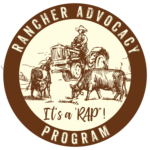 Many small, family-owned ranches and dairies (like some of those at Pt. Reyes) are hurting financially as America and the world transition away from these traditional business which today, with billions more humans, are no longer ecological viable, polluting the ecosystems all our lives depend on (READ HOW).
Many small, family-owned ranches and dairies (like some of those at Pt. Reyes) are hurting financially as America and the world transition away from these traditional business which today, with billions more humans, are no longer ecological viable, polluting the ecosystems all our lives depend on (READ HOW).
Watch this 4 MIN. VIDEO to see a smart, new, forward-thinking way to help ranchers succeed, successfully transition to more sustainable, modern and thus successful plant-based farming practices. LEARN MORE: https://RancherAdvocacy.org
If the video below won’t play, use this YouTube link: https://www.youtube.com/watch?v=jCv13Fs2NvI
ACTIONS YOU CAN TAKE TO HELP THE ELK:
• SIGN PETITION – Takes 30 seconds, shows politicians (and fellow Americans) that thousands of people prefer wild elk over private, polluting cattle operations inside a National Park. Sign & share on social media. https://www.change.org/p/cicely-muldoon-save-the-tule-elk
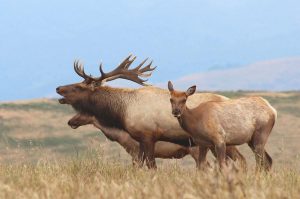 TELL the National Park Service to protect elk, not cows:
TELL the National Park Service to protect elk, not cows:
Takes just 60 sec. to contact each person below. Politely but firmly tell the staffer who answers you want elk free-roaming, not fenced in at Pt. Reyes (or in any) National Park. AND want polluting, private, for-profit cows OUT. And certainly NOT shot, ever! It’s a national park, not a ranch!
1st: CALL THE Sect. of the Interior whom the American public must convince to change the National Park Service policies which favor private cattle operations over wildlife and public parklands.
Say and/or write, “I oppose ALL beef and dairy operations, and oppose the shooting of ANY Tule elk, at Point Reyes National Seashore, ever. Period.”
In addition, immediately implement rigorous, third-party, environmental oversight and enforcement of cattle operations fecal contamination of land and waterways with weekly and unannounced water quality tests.
Sect. of the Interior Deb Haaland, who is empowered to change NPS (National Park Service) policy in Washington, where Point Reyes Nat’l Seashore policy is set:
Interior Secretary Deb Haaland
Department of the Interior
1849 C Street, N.W.
Washington DC 20240
e: Deb_Haaland@ios.doi.gov
t: 202-208-3100 – Press 3 for The Secretary of the Interior
2nd: CALL the National Park Service
• CALL Woody Smeck, Deputy Regional Director, National Park Service
National Park Service (NPS)
333 Bush St., Suite 500
San Francisco, CA 94104-2828
e: woody_smeck@nps.gov ; cc: PORE_Info@nps.gov
t: 415-623-2100
• CALL Craig Kenkel, Superintendent, Point Reyes National Seashore
1 Bear Valley Road
Point Reyes Station, CA 94
e: craig_kenkel@nps.gov
t: 415-464-5102
3rd: CALL the POLITICIANS who support Point Reyes ranching, and lethal Tule elk management, including fenced enclosures:
In order of importance, the politicians to contact (or take 30 sec. to call each, and/or write) are:
1) California Congressman Jared Huffman, California’s 2nd District, who is siding with ranchers because, well, you know the reality: that’s where the money, influence, and power is RIGHT NOW — UNTIL we the people upend this dynamic by letting the Congressman we’re angry, motivated, numerous, and want Point Reyes policy changed to favor wildlife and wildlands, not destructive private cattle operations that were paid millions decades ago to leave the Seashore, yet continue to pollute it daily.
Congressman Jared Huffman
San Rafael, CA 94901
t: 415-258-9657
2) CA Governor Gavin Newsom, (916) 445-2841, gavin@gavinnewsom.com
3) CA Congressman Adam Schiff, (818) 450-2900, https://schiff.house.gov/contact
4) Representative Raul Grijalva in Wash. D.C, Chair of the House Natural Resource Committee: 202-225-2435
5) Last, and sadly least, Senator Diane Feinstein: Call 415-393-0707. 100% captured by Big Ag, so register your disappointment in her fossilized, anti-environmental, pro big business positions which are least likely to change.
• LEARN MORE about the issues from the environmental organizations below that have been educating the public for years, and are committed to protecting elk and all wildlife, especially within U.S. National Parks).
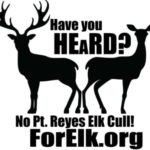 • ForElk.org – local environmental group advocating for tule elk protection and ending cattle operations at Pt. Reyes National Park
• ForElk.org – local environmental group advocating for tule elk protection and ending cattle operations at Pt. Reyes National Park
• In Defense of Animals
• Restore Point Reyes Seashore.org
• The Shame of Point Reyes.org
• Western Watersheds Project.org
• GENERAL INFO on tule elk on Wikipedia
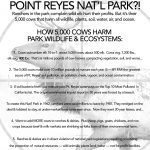 • Elk vs. Cows FACT SHEET – DOWNLOAD, PRINT & SHARE: about the under 600 threatened Pt. Reyes tule elk being killed by cattle ranching. Over 5,600 cows outnumber elk 9:1 and degrade and pollute this precious national seashore.
• Elk vs. Cows FACT SHEET – DOWNLOAD, PRINT & SHARE: about the under 600 threatened Pt. Reyes tule elk being killed by cattle ranching. Over 5,600 cows outnumber elk 9:1 and degrade and pollute this precious national seashore.
Share it with friends, post in public places, etc. CLICK HERE.
• DONATE to TreeSpirit Project, to fund ongoing efforts to protect Pt. Reyes’ Tule elk — all its wild animals from harm, and habitat from degradation — before it’s too late.

